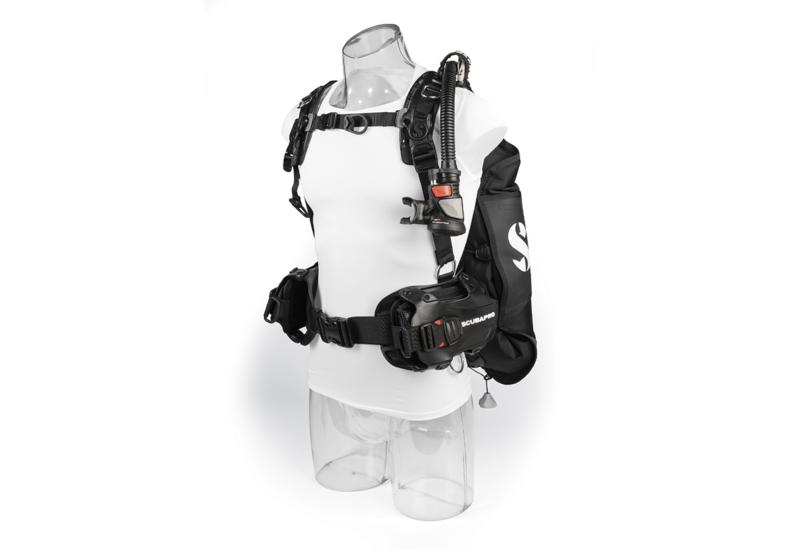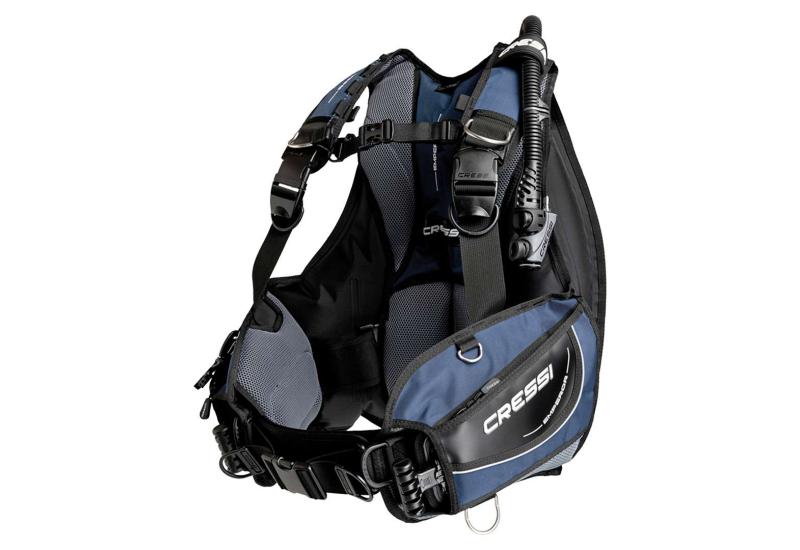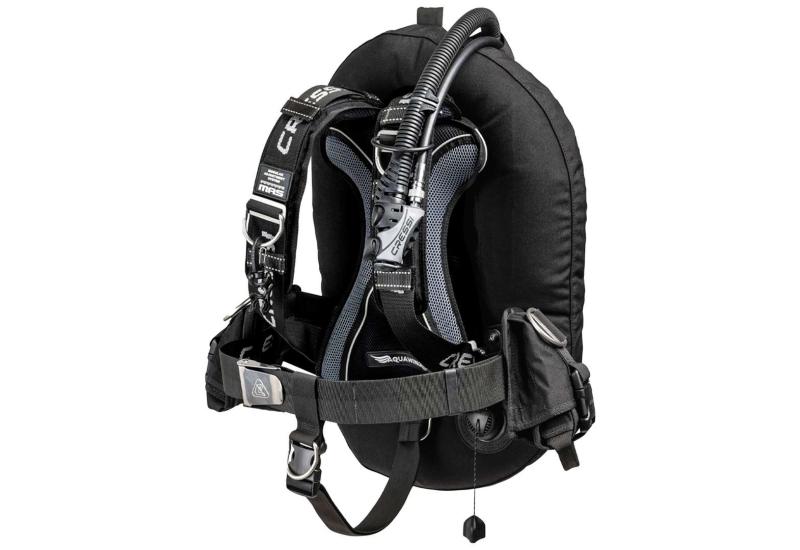The Best New BCs
By Bill Kendig
Photography by Joseph Byrd

Your BC is one of the most complicated pieces of equipment in your gear bag. Not only does it help you adjust and maintain your buoyancy and swimming attitude, it also has to carry your tank and corral all your other gear-all while providing you with a comfortable fit.
Mares Dragon/Dragon ATSCUBA DIVING Testers' ChoiceOceanic Probe LXSCUBA DIVING Testers' ChoiceAeris CoralSCUBA DIVING Testers' Choice
It's no wonder then that the 14 models submitted for evaluation in our Scuba Lab Review of new BCs are a real grab bag. They fall into three categories-Jacket, Back Buoyancy and Travel styles-and have a diverse array of features. Some have been designed to be "all-around" BCs, others have a definite bend toward a specialized use. And while all proved themselves to be useful for recreational diving, only a few had the combination of features, comfort and performance to earn our coveted Testers' Choice rating.
How We Tested Them
Following our standard BC protocols, this test involved three phases. In phase one, the Scuba Lab staff checked each BC to ensure it was functioning correctly. We also reviewed owners' manuals and inspected D-rings, pockets, straps, buckles and bands to verify the accuracy of published specs.
In phase two, we took the BCs to our test pool for a series of objective performance measurements:
Actual buoyancy against manufacturer claims. Good news: We found no remarkable discrepancies.
Inherent buoyancy. This test measures how much lift the BC has when all air is dumped from the air cell. Since every pound of inherent buoyancy in a BC is a pound you have to offset with additional ballast, less inherent buoyancy is always better. More good news: All the BCs in this review have an inherent buoyancy of less than three pounds (an acceptable level). Most have less than two pounds of inherent buoyancy and two models registered as completely neutral.
Valve flow rates. We believe each of a BC's deflate valves should be able to vent the air cell faster than the inflate valve in order to allow the diver to maintain buoyancy control if the inflator valve is stuck in the "on" position. For this test, we anchor the BC to the bottom of our test pool (in 14 feet of fresh water), completely empty and in an upright position for a normal ascent. We simultaneously activate the inflate button and, in turn, each deflate valve in 20-second cycles. At the end of each 20-second period we check to see how much (if any) air has accumulated in the BC. In reality, a diver in a stuck-inflator scenario would use more than one dump valve, but for the purposes of this review, we test each one individually.
Phase three is the fun part-in-water ergonomic testing. We took a team of eight volunteer test divers out for three days of diving. Each diver rated each BC in eight performance categories ranging from ascent control to how well integrated-weight systems work, to how easy it is to access pockets and adjust fit. For each category, test divers use a 1 to 5 scale and record their written comments.
Adding Them Up
Ergonomic scores are weighted in relation to their importance and combined with scores for lack of inherent buoyancy and for performance in the valve flow rate test. Here in order of their total scores, are the individual reviews:
Jacket-Style BCs

This new BC from Mares impressed our test divers with an array of comfort and performance features. The name comes from the wing-like Dragon air cell, which wraps partially around the tank as it expands, providing a more streamlined profile with less body squeeze. The Dragon also comes with the latest version of the MRS Plus integrated-weight system. The zippered weight pouches hold up to 13 pounds each, and an internal Velcro divider allows you to position weights forward if a pouch is only half full-a nice touch. Test divers found the ability to load the weight pouches while wearing the BC to be about average, but gave the system an Excellent rating for weight ditching. The BC also features Mares' neutrally buoyant BPS padding, a comfortable rolled neoprene collar and a plush internal lining that made it one of the most comfortable models in this review. Underwater, divers found the Dragon to be very stable and commented on the comfortable swimming attitude it provided.
The Dragon AT is the same BC only with Mares' innovative Air Trim power inflate/deflate system and a price tag that's $100 higher. While we didn't have the chance to give the AT version a full review, the divers who did get hands-on with the Air Trim liked it-a lot. The control is positioned at the front left side of the air cell, and the buttons are large and intuitive. To deflate, the Air Trim uses air pressure from your tank to simultaneously activate exhaust valves on the left shoulder and the right rear. We found it to be very efficient at dumping air, and after only a dive or two, felt it was as easy to use as a standard inflator.

The Probe LX tied with the Mares Dragon for the highest total score in this year's review. The BC features a Bioflex air cell, which Oceanic says stretches up to 30 percent over conventional BC materials, providing greater lift in a streamlined profile. The chest strap offers alternate positions and tightens from both sides. Top-loading pockets are large and have grommets installed for adding an optional knife or accessories. Need a place for your signal tube or backup light? Just reach back and on each side you'll find a small, vertical zippered pocket that's just the right size. Diving the Probe LX is a very tactile experience, with all features designed to be easy to find and operate, even with gloves. The inflator feels right at home in your hand with large buttons, the remote dump valves are activated by large toggles placed within easy reach, and large plastic D-rings on the shoulder straps make adjustments a cinch. The Probe LX was the only BC in this review to earn an Excellent rating for ease of assembly. Test divers also applauded the extra security of the patented QLR weight system giving it a Very Good rating for both loading and ditching.

The Coral proved to be one of the best all-around BCs we tested, with Very Good scores across the board in all ergonomic categories. Test divers told us they liked how the wide, reinforced shoulders helped disperse the load of the tank, and how the baffled air-cell design reduced squeeze when the BC is fully inflated. The cummerbund is adjustable and it's depth-compensating for added snugness. Shoulder buckles have extended tabs for easy loosening, and the sternum strap is adjustable for high or low placement. Integrated weight pouches hold 20 pounds and are secured with mechanical buckles. Trim-weight pouches (they hold five pounds each) are mounted on the tank band, making them easy to load. Two top-loading gear pockets are big and accessed by large zippers with extended pull-tabs that come to the front of the BC, making them easy to locate and operate even with gloves.
XS Scuba Nekton
SCUBA DIVING Testers' Choice

The Nekton from XS Scuba is a jacket-style BC built on a semi-soft MicroPac frame. While the majority of the backpack is soft, and therefore lighter and easier to pack, there are two plastic reinforcement pads where the tank bands attach, offering a stability that rivals a hard pack. There are a lot of nice features on this BC: A soft backpad and rolled neoprene collar make it very comfortable, while plastic D-rings at the end of adjustment straps and extended pull tabs make the shoulders easy to adjust. The efficient weight system holds 20 pounds and uses a combination of mechanical buckles with Velcro for extra security. The Nekton also has two rear trim-weight pouches that hold five pounds each and they, too, can be released if you really work at it. The remote exhaust valves have pull dump cords that are routed to the front with large toggles that are easy to find and use, even with gloves. Test divers were less impressed with the tank bands, which tend to slide through the plastic pad unless held while cinching the buckles. As a result, they gave the BC only average scores for Assembly. And while they liked the adjustable, depth-compensating cummerbund, they would have preferred an adjustable waist strap as opposed to the Nekton's small elastic one. On the plus side: The Nekton was one of two BCs in this review to register zero inherent buoyancy.
Aeris SportVery Good Performer

The Sport is the budget version of the Coral BC, and while it comes with the same baffled air cell, efficient integrated-weight system and slimline power inflator, it sacrifices some of the Coral's nicer features in order to carry a price tag that's about $100 less. The biggest things you give up are the reinforced shoulders, the right shoulder deflate valve and depth-compensating cummerbund. Minor trade-offs include Velcro pocket closures instead of zippers and plastic D-rings instead of metal (there are also fewer D-rings on the Sport). While it didn't score enough points to be a Testers' Choice, the Aeris Sport is a great all-around BC. "This is a good baseline model. It works the way you expect it to," noted one test diver.
Back-Buoyancy Style
Apeks WTX
SCUBA DIVING Testers' Choice

"Rugged," "adjustable," "versatile" and "comfortable" are some of the words test divers used to describe the Apeks WTX series BC. This modular system allows the diver to choose a harness, air cell and accessories to fit his specific needs. The unit we tested included the WTX harness, WTX 3 buoyancy cell, and the SureLock weight system. In this configuration, the BC is a soft pack with two tank bands, but can be used with a metal backplate for double tanks. This impressed the most experienced tech diver on our team, who commented, "I would buy this." Some test divers thought the WTX a bit complex for single-tank diving, but agreed it had "all the right stuff," and the scores clearly put it into the Testers' Choice category. The SureLock weight system was one of the easiest to load and ditch and earned the WTX one of only two Excellent ratings for weight ditching. The two-inch webbing straps, backed by shoulder pads, are very comfortable, as was the thick, removable backpad. A two-inch crotch strap, which prevents tank shifting, also helped the WTX earn an Excellent rating for swimming attitude and stability. The heavy-duty power inflator operated efficiently, but most test divers found it to be bulky. On the plus side: The WTX was one of two BCs in this review to register zero inherent buoyancy.
Oceanic ExcursionSCUBA DIVING Testers' ChoiceSherwood Scuba AxisVery Good PerformerOceanic OutriggerVery Good PerformerRiptide RebelGood PerformerSea Quest MalibuSCUBA DIVING Testers' Choice

The Excursion BC from Oceanic is rigged and ready for the wreck or reef and offers all the features needed for taking that first tech course. Warm-water divers will like the padded backpack and rolled neoprene collar for comfort when wearing a thin suit. The patented Bioflex back-buoyancy air cell is streamlined and packs flat in your bag. All straps are finished with plastic D-rings for easy fit and the adjustable cummerbund and multi-position sternum strap offer customizing options. Test divers had nothing but praise for the QLR integrated-weight system. The pouches hold 20 pounds and are secured with mechanical buckles backed with Velcro. There are also two rear weight pouches that can hold up to 10 pounds. Pre-bent stainless steel D-rings are located on the shoulders and bottom rear to accommodate deco bottles. A medium size drop-down gear pocket on the right side can hold a light or accessories while grommets are available on the left for retractors and a knife.

If you want one BC that can pamper you in warm water, yet has the lift and weight capacity for cold water, it's the Axis. The feature-rich BC packs a lot into its streamlined frame. On the left is a small light pocket with an attachment clip, fastex buckle and a stainless D-ring. On the right are a drop-down zippered cargo pocket, fastex buckle, stainless D-ring and a scuba tube pocket. Sherwood's patented CQR weight system holds 20 pounds and two trim pouches hold an additional 10 pounds. Pre-bent stainless D-rings on both shoulders make clipping off gear a snap. The optional BC Pro Kit that is also available includes a large and small retractor, BC knife and halogen pocket light. The CQR weight system loads easily, holds securely and ditches well, and earned a Very Good rating from our test divers. Comfort and Adjustment scores also fell into the Very Good range, due to the plush padded backpack, rolled neoprene collar and long adjustment straps with D-rings. Wide, contoured shoulders provided stable comfort when loaded down, and test divers noted that the Axis was very stable underwater.

The Outrigger is a very comfortable and stable back-buoyancy BC with a unique bonus feature. The BC is named for its innovative High Lift Transfer (HLT) system that transfers air from the main air cell to a small pontoon on the cummerbund, which provides an additional 15 pounds of lift at the surface. It's designed to help float the diver face-up and test divers said it works as intended, though most felt the BC was fine without it, too. All adjustment straps are finished with plastic D-rings and shoulder buckles have extended tabs for easy loosening. The elastic cummerbund is adjustable and compensates for depth, while the sternum strap offers three positions. The QLR weight system holds 20 pounds, while rear trim pouches hold an additional 10. Test divers liked the extra security of the QLR weight system, giving it an overall rating of Very Good. The Outrigger also scored high marks for comfort and adjustability, thanks to a padded backpad, velour lining, rolled neoprene collar and elastic cummerbund.

With a shiny black outer shell and biker-inspired logo, the new Rebel from Riptide has a distinctive Easy Rider look. This bad boy BC has a soft side though, incorporating a two-band soft-pack design. The integrated weight pouches hold 24 pounds, and trim pouches can be mounted on either tank band, with each pouch holding up to five pounds. An adjustable depth-compensating cummerbund, webbing waist strap and sternum strap offer a snug fit. A reinforced carry handle and tank-positioning strap make setup and tank changes smooth. The Rebel's integrated-weight system is one of only two in this review that don't use removable pouches. The weight pockets are loaded through a zipper in the top and ditched by pulling on a ripcord-style handle on the outside flap. Loading and Ditching functions both earned a Good rating from test divers. Testers also found the Rebel to be very stable while diving and told us that the old-school inflator was efficient, but slightly bulky. Ergo scores for this BC suffered from the absence of pockets. There's just one small zippered compartment on the front of the cummerbund.
Travel BCs

Simple, quick and portable describes the new Malibu from Sea Quest and explains how it ranked first among these Travel BCs. Slide it on, click two buckles (one for the waist strap, one for the sternum strap), and you're ready to dive. Bonus: The Malibu can be carried, rinsed and stowed in its own built-in mesh bag. Extras are few but useful, including one large drop-down pocket on the right side, five D-rings and grommets for adding a knife or retractor. The Quick Draw weight system scored big with 20 pounds capacity plus an additional 10 pounds in trim pouches. Testers found them to be some of the easiest to load and ditch of those tested. Adjustment scores were Good, thanks to long shoulder straps appointed with D-rings and weaved through buckles with extended tabs for easy loosening. Test divers also found the BC to be comfortable, thanks to velour lining on the shoulders and back.
Cressi-sub Aqualight R
Very Good Performer

At first glance it's easy to mistake the Aqualight R for just another jacket-style BC, but when you pick up this lightweight model (dry weight: 5.8 pounds) you realize it's been custom-made for tropical travel. Test divers found it to be a very stable BC, thanks to dual tank bands that are webbed together to create a solid connection to the harness. The Aqualight received Good to Very Good ratings in most of the ergonomic tests, but only a Fair rating for weight loading and ditching. The reason? Instead of the detachable weight pouches found on most of the other BCs in this review, the Aqualight uses folding, drop-down weight pouches that open for loading and ditching when you squeeze a quick-release buckle. They work as intended, but compared to detachable systems, test divers said they seemed slightly awkward, especially when it came to loading the pockets while wearing the BC. That said, their comments indicated a fondness for the BC, with praise for precise ascent control, thanks to a slim and responsive inflator that fits well in the hand. They also liked the placement and operation of the pull dump toggles, which are easy to find and use.
Tusa PassageVery Good PerformerXS Scuba CompanionFair PerformerMares Vector Epic

The Passage is a light (less than 5.5 pounds), durable (made from 420 denier nylon), and comfortable BC that offers excellent stability. The tank is secured between two rails to prevent wobble, and an additional stabilizing strap and tank-positioning strap make the connection rock solid. The Integrated Stabilizing Harness, which incorporates an adjustable cummerbund, shoulder straps and a waist strap, provides a snug, comfortable fit that is unaffected by changes in the air cell. The integrated-weight system holds 16 pounds in detachable pouches, which is sufficient for most warm-water divers. The weight pouches slide into dedicated sleeves at a 45-degree angle, which makes them somewhat awkward to reach when it's time to ditch. But the main issue test divers had with the system was in loading-the pouch handles must be lined up just right with the Velcro tabs to ensure security. All in all, test divers liked the Passage, giving it Very Good scores for Ascent Control and Comfort. There were positive comments on the streamlined inflator, which has a bright orange inflate button that is easy to recognize.

The new Companion from XS Scuba is a bare-bones BC designed for those quick getaway trips to the tropics. The Companion is actually the marriage of XS Scuba's Pony Pack harness and its 30-pound air cell. It features a semi-soft MicroPac with two tank bands. The overall rig is light (five pounds) and folds flat in the bottom of your bag. This BC is so stripped down it's easier to point out what it doesn't have: weight pockets, trim pockets or stowage pockets. It does have an adjustable Velcro waist strap, shoulder straps with easy-to-adjust buckles, a rolled neoprene collar, a padded velour backpad and just two D-rings. The Companion earned Good scores across the board, but divers found the adjustability to be lacking compared to others tested. All in all, it's a super simple design that's great for warm water, but lacks the adjustability needed in cold or temperate waters.
Dive In
Ergonomic Testing: The Human Touch
Ergonomics is a fancy word for how gear fits, feels and functions in everyday use. And the only way to evaluate the ergonomics of a product like a BC is to put it into the hands of real people. That's why the feedback we get from our diverse team of volunteer test divers is so important to these reviews.
Representing a cross-section of the sport in terms of age, gender, experience and diving interests, our test divers are your stand-ins, doing what you would do if you could-namely, dive the heck of out of each BC submitted for review. On each dive, test divers used a pre-printed scorecard to evaluate each BC in eight specific areas of performance using a 1 to 5 scale (5=Excellent, 4=Very Good, 3=Good, 2=Fair, 1=Poor). They are also instructed to provide written comments on specific features as well as their overall impressions of the BC. The areas of ergonomic evaluation are grouped into three categories-Most Important, Moderately Important and Convenience Items as follows:
MOST IMPORTANT
Ascent Control: An evaluation of how easily the BC can be used to control a normal ascent.
Attitude and Stability: Evaluated while swimming under water to determine if the BC will keep the diver in the proper swimming position without wobbling.
Weight Ditching: An evaluation of how easy or difficult it is to ditch weights in a simulated emergency situation.
MODERATELY IMPORTANT
Valve Operation: Evaluated by the ease with which a diver can find and use the oral and power inflators, the oral deflate held overhead, the pull dump and the remote exhaust valve(s).
Comfort and Adjustment: Checked both in and out of the water with the BC strapped to a tank.
CONVENIENCE ITEMS
Assembly: Performed on deck without instructions. Although BCs should be supplied with clear and complete instructions, most divers will not take the instructions with them on the boat.
Weight Loading: An evaluation of how easy or difficult it is for a diver to load weights and secure the system while wearing the BC.
Pockets: Tested in and out of the water, this is an evaluation of how easy or difficult it is to access and use pockets.
Still Looking for the Perfect BC?
These Testers' Choice models from the 2005 Scuba Lab review of travel BCs are still on the market and worth a look. For full details, see the Gear section of www.scubadiving.com.
Sea Quest Balance One of 2005's top-scoring BCs, the Balance is as comfy as they come thanks to an expandable waist strap (it replaces the traditional cummerbund), unique shoulder swivel buckles and a triangular load distribution strap system. This back-buoyancy model also uses Sea Quest's efficient Sure-Lock mechanical-release weight system. Weights load easily and ditch like a dream. Price: $535.
Sherwood Scuba Tortuga The travel-friendly Tortuga has a sweet integrated-weight system that puts ballast pouches and locking mechanisms up front where they're easy to reach. It's a comfortable BC, with a thin layer of velour-covered padding that cushions the back and lumbar areas, more substantial padding underneath the shoulders, and a nice neoprene neck roll. It also has a nicely designed power inflator that fits comfortably in the hand. Price: $475.
Sea Quest Passport This jacket-style BC comes with its own integrated mesh carry bag. When not in use, the bag stows behind the backpad, providing additional lumbar support. The design keeps things simple, but the BC has everything you need for stable, comfortable diving. An efficient power inflator simplifies ascent control and the integrated-weight system is easy to load and ditch. Price: $349.
Genesis Scuba Tropic The back-inflation Tropic has an excellent integrated-weight system, efficient adjustments throughout and comfortable shoulder and back padding. Test divers found it to be a very stable BC thanks to dual tank bands and a semi-rigid backpack. They also loved the power inflator, which has a good angle to its mouthpiece and easy-to-operate buttons, enabling you to inflate and deflate without changing hand positions. Price: $350.
Zeagle Stiletto The back-inflation Stiletto is one of Zeagle's most popular BCs, thanks to comfy lumbar padding and Zeagle's PFS (Personal Fit System) sizing, which lets you choose from five vest sizes and five shoulder strap sizes for the best possible fit. The Stiletto is equipped with Zeagle's patented "Ripcord" weight-release system. Weight pockets are tied together with a threaded cord connected to one handle. A single pull drops all weights. In spite of the heavy-duty materials and copious padding, this BC folds up pretty compactly for traveling, and it has virtually no inherent buoyancy. Price: $539.
Oceanic Islander Nice velour-covered padding on the back and lumbar region, a rolled neoprene neck and cushy shoulders soften the load when diving the Islander in tropical locales. And rather than offering D-rings for attaching gear, the Islander comes with 16 looped attachment points to which you can clip carabineers (two are included) right where you need them. Offering a stable ride at depth (the BC has no inherent buoyancy), the Islander's shoulder straps snake underneath the arms, allowing you to achieve a snug fit while clearing the chest area of clutter. Price: $439.
BC Buying Advice
The single most important thing to look for in a BC is a snug, comfortable fit. Your BC and tank should move with you like an extension of your body, and when you add air to your BC on the surface, it should lift your body, not float off you. When you're trying a BC on for size, here's how to find one that is a perfect fit for your body:
Suit up. Wear the exposure suit you're most likely to use with the BC. Then mount the BC to a tank before trying it on.
Start with the cummerbund. Leave all other straps loose, and tighten the cummerbund (or waist strap if there is no cummerbund) until the weight of the tank rests comfortably snug on your hips. If it's a Velcro closure, there should be about four inches of overlap, so you can adjust for either a thinner suit or a thicker one. If the cummerbund is obviously too short or too long, ask the store personnel to show you how to adjust the length.
Buckle up. Start with the chest strap. Cinch it to a comfortable position. Next, take the slack out of the shoulder straps, but don't overtighten them. Now look in a mirror. Buckles should be in the middle of their adjustment ranges.
Inflate the BC all the way. If there is body squeeze, make sure it doesn't restrict your breathing or mobility.
Deflate the BC. Twist left and right. Walk around the store a little. Your BC and tank should move with you like an extension of your body.
Load it and ditch it. With weight-integrated BCs, load the pouches with the normal amount of weight you wear on a dive. Now, without looking, see how easy and intuitive it is to quick-ditch the weight pockets.
Flow Rates
We test flow rates to determine whether or not a BC's deflation valves will stay ahead of the inflation valve to avoid an out-of-control ascent in the event the inflation valve sticks open. In a heads-up ascent position, starting out with the BC totally empty, the inflation valve was simultaneously activated for 20 seconds with each of the deflation valves to answer the question, "Can the deflate valve in question stay ahead of inflation?" BCs earn a point for each "Yes" listed on the chart below.
| Name | Inflator/Deflator Held Overhead | Exhaust Hose Pull Dump | Alternate Shoulder Pull Dump |
| Aeris Coral | No | Yes | Yes |
| Aeris Sporta | No | Yes | N/A |
| Cressi-sub Aqualight R | Yes | Yes | Yes |
| Mares Dragon | Yes | Yes | Yes |
| Oceanic Probe LX | Yes | Yes | Yes |
| Tusa Passage | Yes | Yes | N/A |
| XS Scuba Nekton | Yes | Yes | Yes |
| Apeks WTX | Yes | N/A | N/A |
| Oceanic Excursion | No | Yes | N/A |
| Oceanic Outrigger | No | Yes | Yes |
| Sea Quest Malibu | Yes | Yes | Yes |
| Riptide Rebel | Yes | Yes | N/A |
| Sherwood Scuba Axis | Yes | Yes | Yes |
| XS Scuba Companion | No | Yes | N/A |
Late Arrivals
While these BCs were not available at the time of testing, they are in stores now.

The Mares Vector Epic is an entry-level, weight-integrated jacket-style BC, whose rugged look is backed up with 420 denier nylon. For comfort it offers the BPS (Back Protection System), an adjustable, depth-compensating cummerbund, and EZ adjust shoulder buckles. It also features the new MRS Plus weight-release system that can hold 26 pounds of ballast. Lift capacity is good at 41 pounds (size large). Two remote dump valves (shoulder, rear) are standard for better control. Two large zippered cargo pockets have extended pull-tabs for easy access. Extras include: a signal whistle, three D-rings, one fastex QR buckle and a double-hose clip. Price: $375.
The DeepOutdoors D2

DeepOutdoors combines both back and front inflation with the new D2 BC. The D2 dual inflation system transfers air from the back bladder to the front bladder when a diver surfaces, providing a more upright, natural position, according to DeepOutdoors. Features include the patented G5 Webloc weight system, two external pockets, one belly pouch, and a Velcro cummerbund. The DeepOutdoors D2 is available in XS/SM and M/L. Price: $875.
By Bill Kendig
Photography by Joseph Byrd
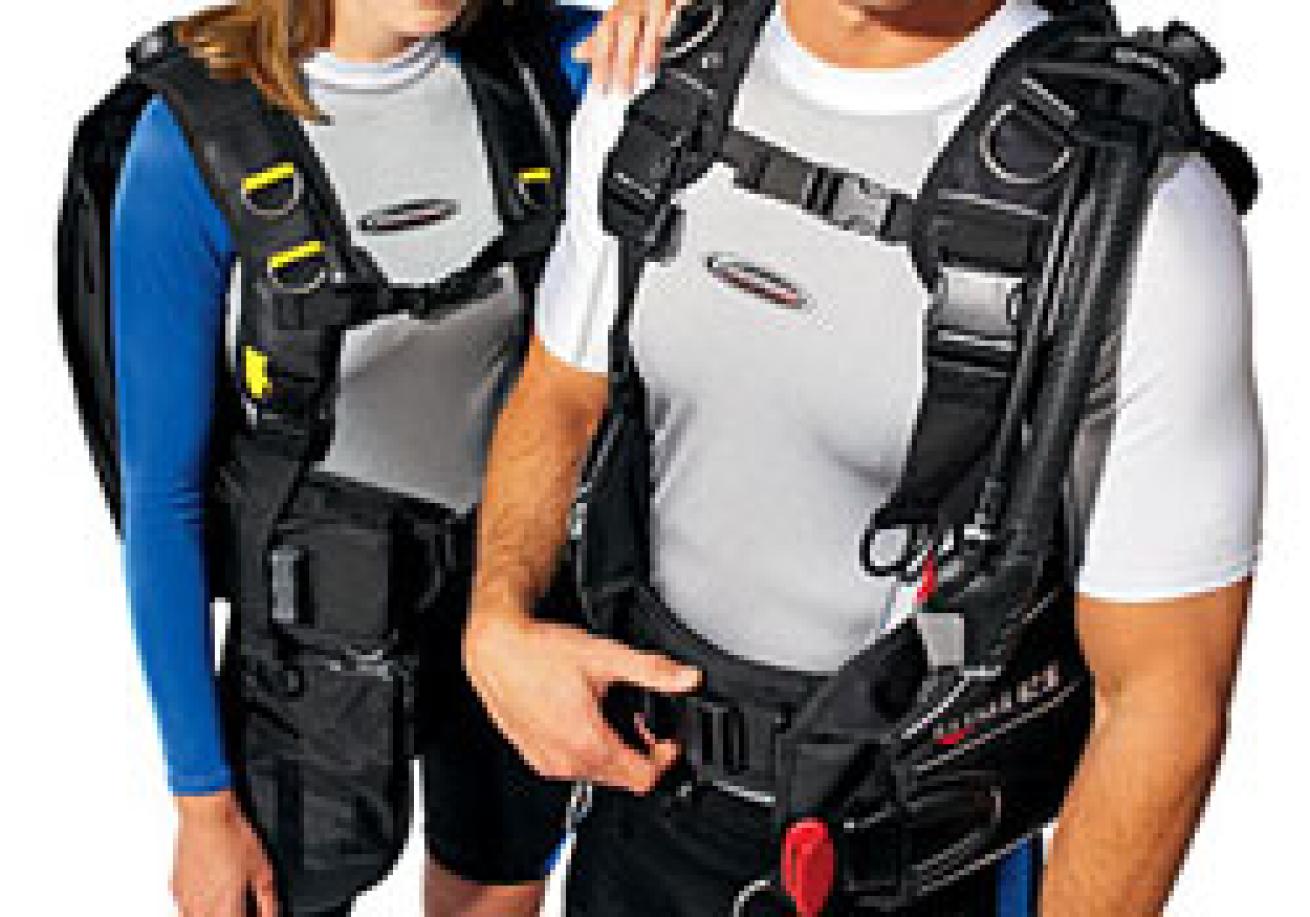
Your BC is one of the most complicated pieces of equipment in your gear bag. Not only does it help you adjust and maintain your buoyancy and swimming attitude, it also has to carry your tank and corral all your other gear-all while providing you with a comfortable fit.
It's no wonder then that the 14 models submitted for evaluation in our Scuba Lab Review of new BCs are a real grab bag. They fall into three categories-Jacket, Back Buoyancy and Travel styles-and have a diverse array of features. Some have been designed to be "all-around" BCs, others have a definite bend toward a specialized use. And while all proved themselves to be useful for recreational diving, only a few had the combination of features, comfort and performance to earn our coveted Testers' Choice rating.
How We Tested Them
Following our standard BC protocols, this test involved three phases. In phase one, the Scuba Lab staff checked each BC to ensure it was functioning correctly. We also reviewed owners' manuals and inspected D-rings, pockets, straps, buckles and bands to verify the accuracy of published specs.
In phase two, we took the BCs to our test pool for a series of objective performance measurements:
Actual buoyancy against manufacturer claims. Good news: We found no remarkable discrepancies.
Inherent buoyancy. This test measures how much lift the BC has when all air is dumped from the air cell. Since every pound of inherent buoyancy in a BC is a pound you have to offset with additional ballast, less inherent buoyancy is always better. More good news: All the BCs in this review have an inherent buoyancy of less than three pounds (an acceptable level). Most have less than two pounds of inherent buoyancy and two models registered as completely neutral.
Valve flow rates. We believe each of a BC's deflate valves should be able to vent the air cell faster than the inflate valve in order to allow the diver to maintain buoyancy control if the inflator valve is stuck in the "on" position. For this test, we anchor the BC to the bottom of our test pool (in 14 feet of fresh water), completely empty and in an upright position for a normal ascent. We simultaneously activate the inflate button and, in turn, each deflate valve in 20-second cycles. At the end of each 20-second period we check to see how much (if any) air has accumulated in the BC. In reality, a diver in a stuck-inflator scenario would use more than one dump valve, but for the purposes of this review, we test each one individually.
Phase three is the fun part-in-water ergonomic testing. We took a team of eight volunteer test divers out for three days of diving. Each diver rated each BC in eight performance categories ranging from ascent control to how well integrated-weight systems work, to how easy it is to access pockets and adjust fit. For each category, test divers use a 1 to 5 scale and record their written comments.
Adding Them Up
Ergonomic scores are weighted in relation to their importance and combined with scores for lack of inherent buoyancy and for performance in the valve flow rate test. Here in order of their total scores, are the individual reviews:
Jacket-Style BCs
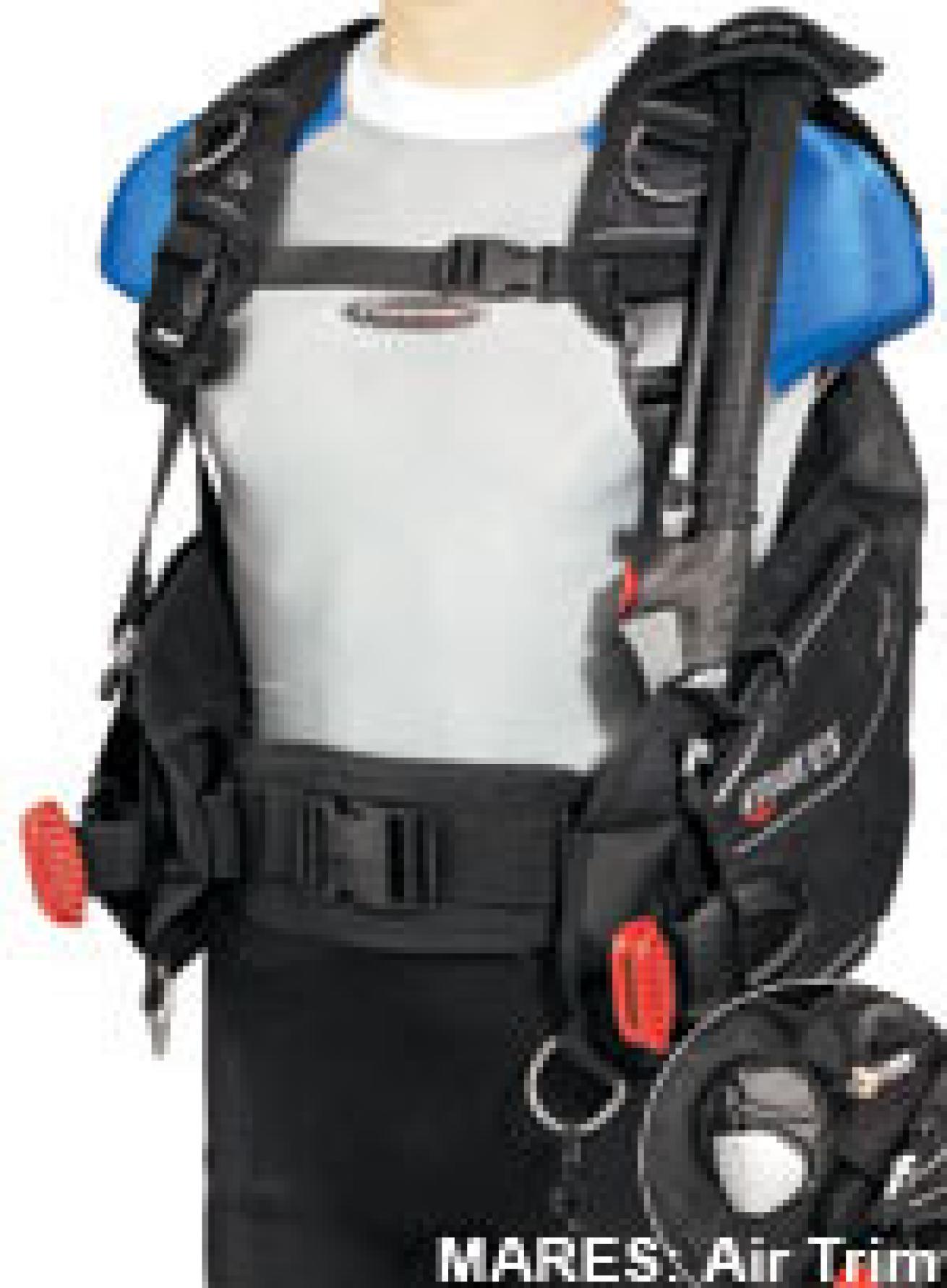
Mares Dragon/Dragon AT
SCUBA DIVING Testers' Choice
This new BC from Mares impressed our test divers with an array of comfort and performance features. The name comes from the wing-like Dragon air cell, which wraps partially around the tank as it expands, providing a more streamlined profile with less body squeeze. The Dragon also comes with the latest version of the MRS Plus integrated-weight system. The zippered weight pouches hold up to 13 pounds each, and an internal Velcro divider allows you to position weights forward if a pouch is only half full-a nice touch. Test divers found the ability to load the weight pouches while wearing the BC to be about average, but gave the system an Excellent rating for weight ditching. The BC also features Mares' neutrally buoyant BPS padding, a comfortable rolled neoprene collar and a plush internal lining that made it one of the most comfortable models in this review. Underwater, divers found the Dragon to be very stable and commented on the comfortable swimming attitude it provided.
The Dragon AT is the same BC only with Mares' innovative Air Trim power inflate/deflate system and a price tag that's $100 higher. While we didn't have the chance to give the AT version a full review, the divers who did get hands-on with the Air Trim liked it-a lot. The control is positioned at the front left side of the air cell, and the buttons are large and intuitive. To deflate, the Air Trim uses air pressure from your tank to simultaneously activate exhaust valves on the left shoulder and the right rear. We found it to be very efficient at dumping air, and after only a dive or two, felt it was as easy to use as a standard inflator.
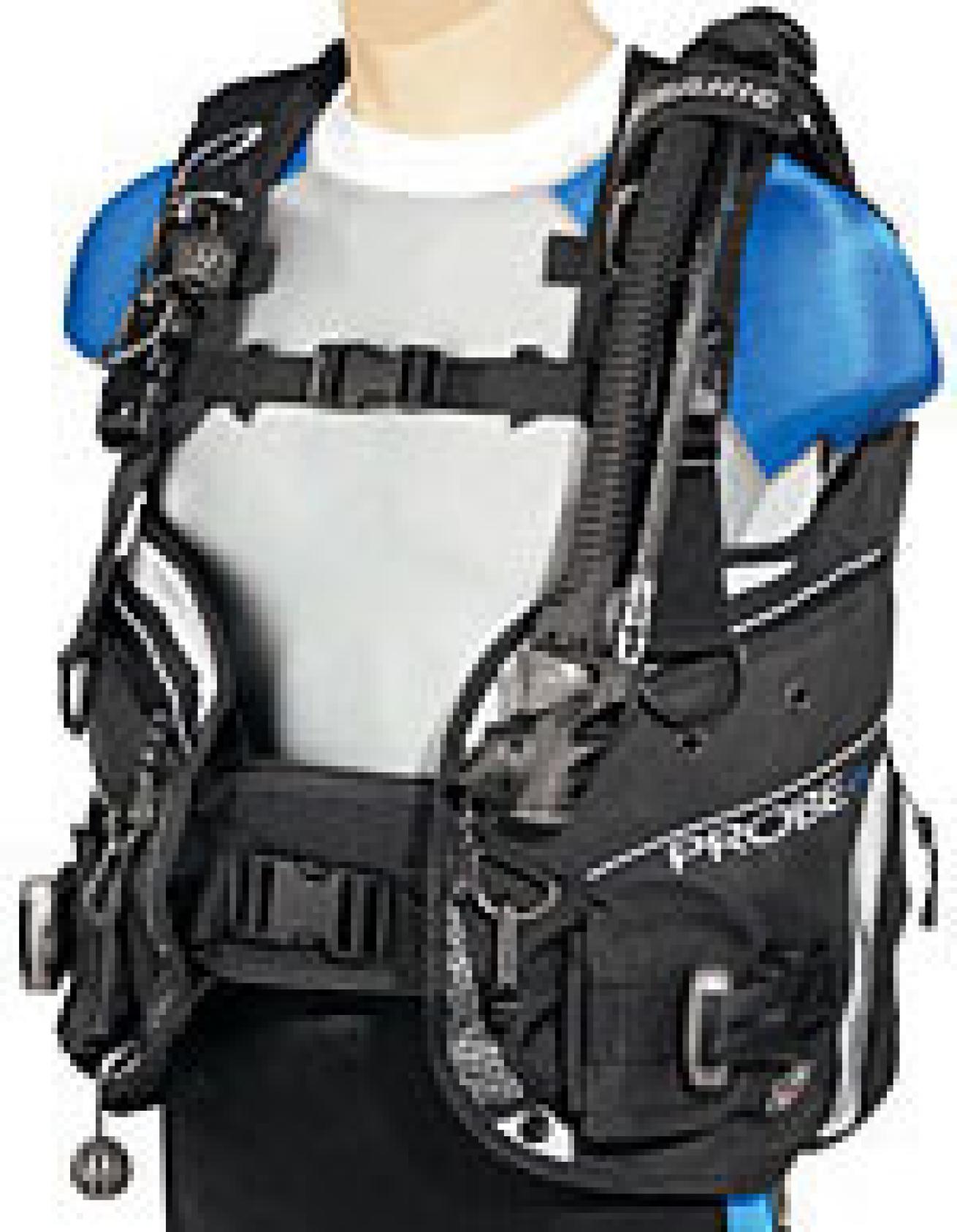
Oceanic Probe LX
SCUBA DIVING Testers' Choice
The Probe LX tied with the Mares Dragon for the highest total score in this year's review. The BC features a Bioflex air cell, which Oceanic says stretches up to 30 percent over conventional BC materials, providing greater lift in a streamlined profile. The chest strap offers alternate positions and tightens from both sides. Top-loading pockets are large and have grommets installed for adding an optional knife or accessories. Need a place for your signal tube or backup light? Just reach back and on each side you'll find a small, vertical zippered pocket that's just the right size. Diving the Probe LX is a very tactile experience, with all features designed to be easy to find and operate, even with gloves. The inflator feels right at home in your hand with large buttons, the remote dump valves are activated by large toggles placed within easy reach, and large plastic D-rings on the shoulder straps make adjustments a cinch. The Probe LX was the only BC in this review to earn an Excellent rating for ease of assembly. Test divers also applauded the extra security of the patented QLR weight system giving it a Very Good rating for both loading and ditching.
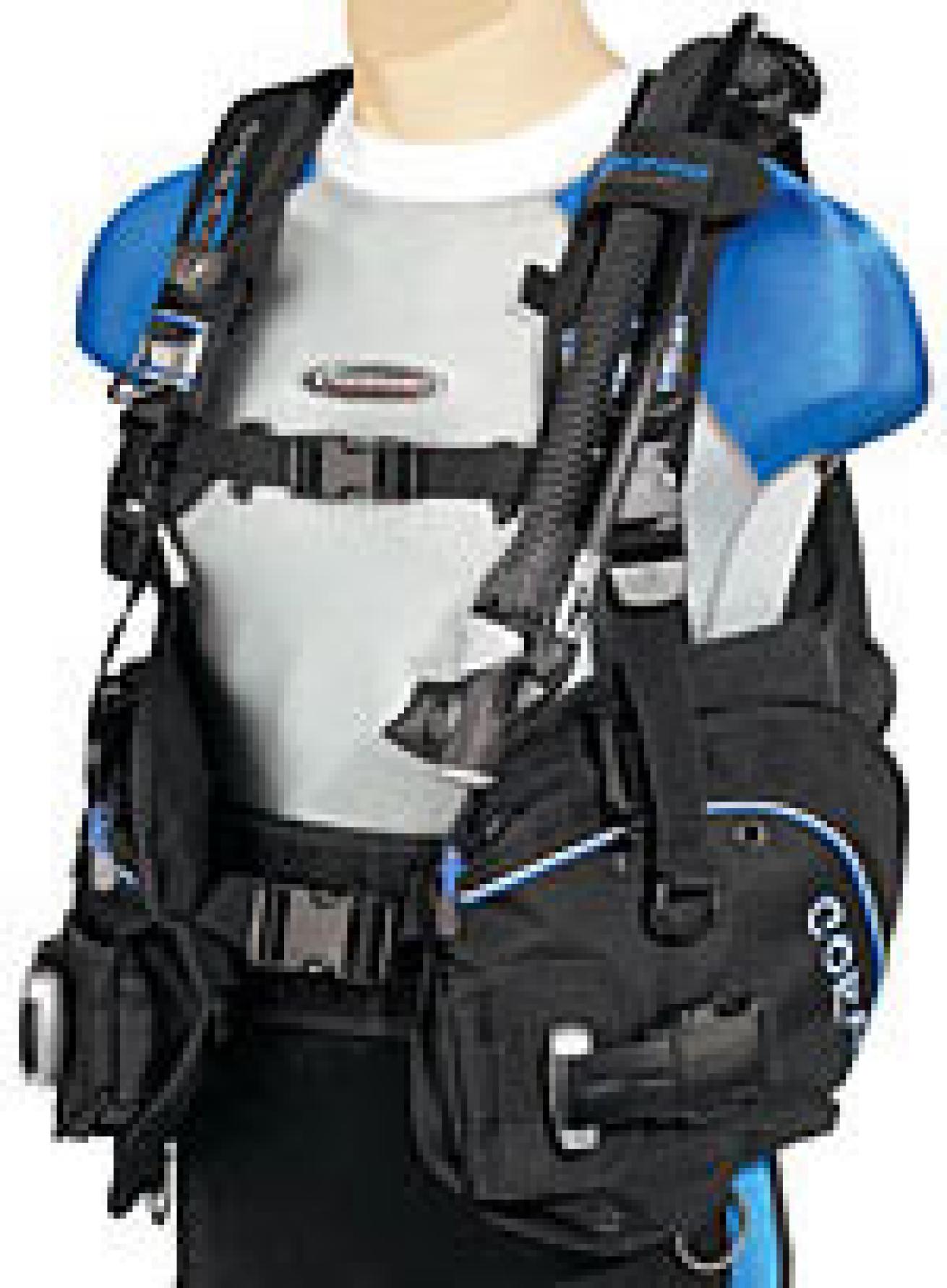
Aeris Coral
SCUBA DIVING Testers' Choice
The Coral proved to be one of the best all-around BCs we tested, with Very Good scores across the board in all ergonomic categories. Test divers told us they liked how the wide, reinforced shoulders helped disperse the load of the tank, and how the baffled air-cell design reduced squeeze when the BC is fully inflated. The cummerbund is adjustable and it's depth-compensating for added snugness. Shoulder buckles have extended tabs for easy loosening, and the sternum strap is adjustable for high or low placement. Integrated weight pouches hold 20 pounds and are secured with mechanical buckles. Trim-weight pouches (they hold five pounds each) are mounted on the tank band, making them easy to load. Two top-loading gear pockets are big and accessed by large zippers with extended pull-tabs that come to the front of the BC, making them easy to locate and operate even with gloves.
XS Scuba Nekton
SCUBA DIVING Testers' Choice
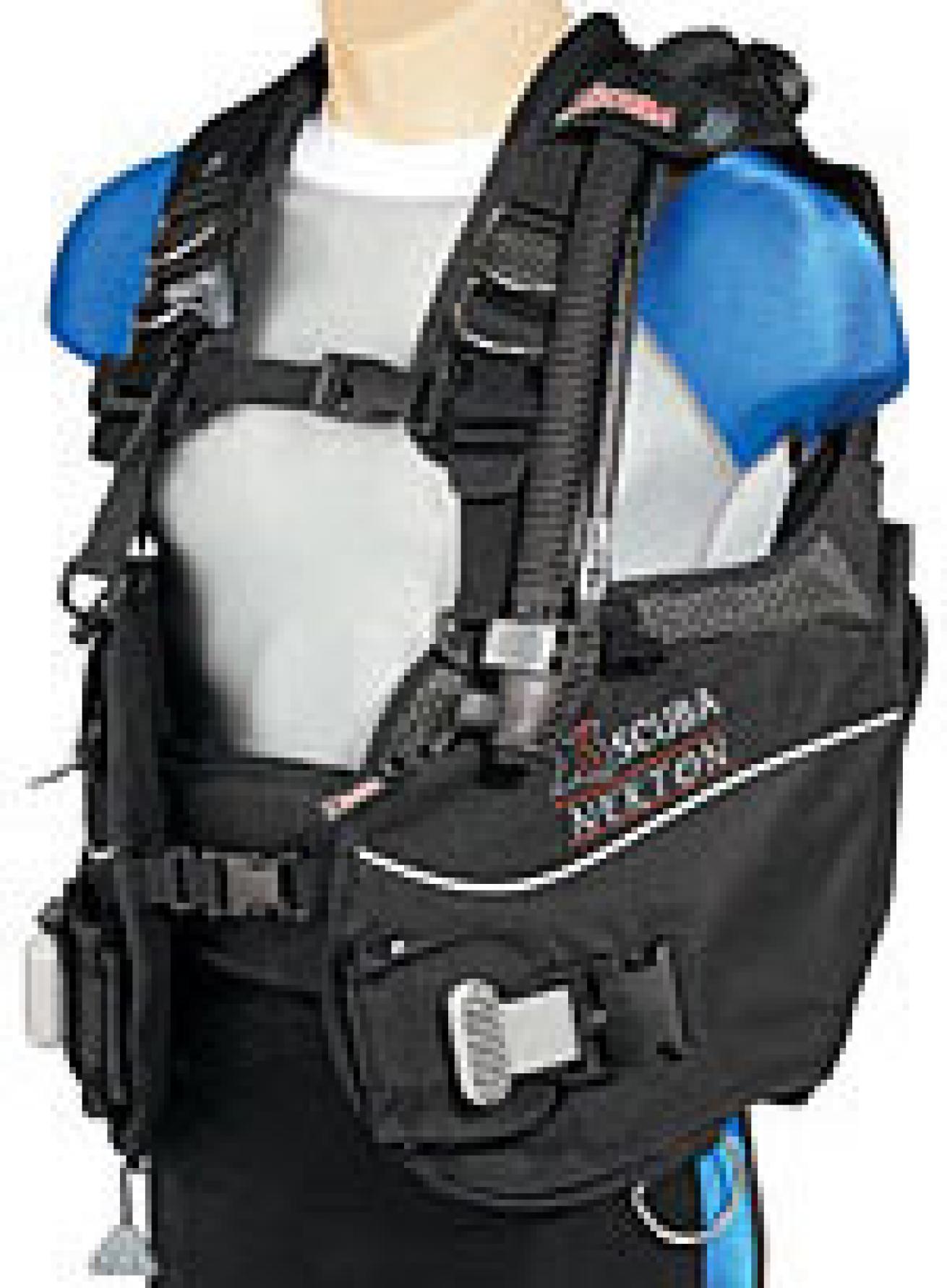
The Nekton from XS Scuba is a jacket-style BC built on a semi-soft MicroPac frame. While the majority of the backpack is soft, and therefore lighter and easier to pack, there are two plastic reinforcement pads where the tank bands attach, offering a stability that rivals a hard pack. There are a lot of nice features on this BC: A soft backpad and rolled neoprene collar make it very comfortable, while plastic D-rings at the end of adjustment straps and extended pull tabs make the shoulders easy to adjust. The efficient weight system holds 20 pounds and uses a combination of mechanical buckles with Velcro for extra security. The Nekton also has two rear trim-weight pouches that hold five pounds each and they, too, can be released if you really work at it. The remote exhaust valves have pull dump cords that are routed to the front with large toggles that are easy to find and use, even with gloves. Test divers were less impressed with the tank bands, which tend to slide through the plastic pad unless held while cinching the buckles. As a result, they gave the BC only average scores for Assembly. And while they liked the adjustable, depth-compensating cummerbund, they would have preferred an adjustable waist strap as opposed to the Nekton's small elastic one. On the plus side: The Nekton was one of two BCs in this review to register zero inherent buoyancy.
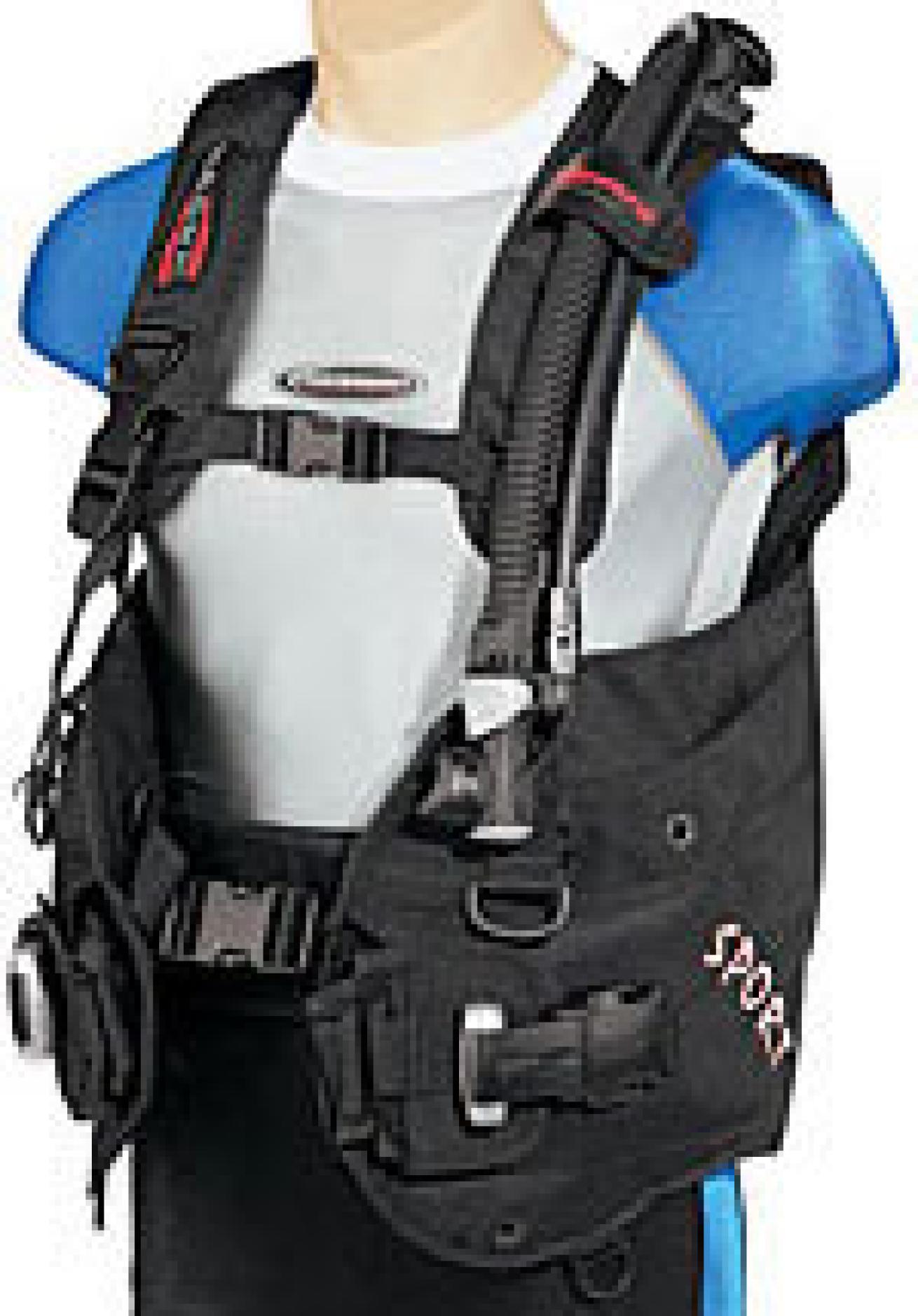
Aeris Sport
Very Good Performer
The Sport is the budget version of the Coral BC, and while it comes with the same baffled air cell, efficient integrated-weight system and slimline power inflator, it sacrifices some of the Coral's nicer features in order to carry a price tag that's about $100 less. The biggest things you give up are the reinforced shoulders, the right shoulder deflate valve and depth-compensating cummerbund. Minor trade-offs include Velcro pocket closures instead of zippers and plastic D-rings instead of metal (there are also fewer D-rings on the Sport). While it didn't score enough points to be a Testers' Choice, the Aeris Sport is a great all-around BC. "This is a good baseline model. It works the way you expect it to," noted one test diver.
Back-Buoyancy Style
Apeks WTX
SCUBA DIVING Testers' Choice
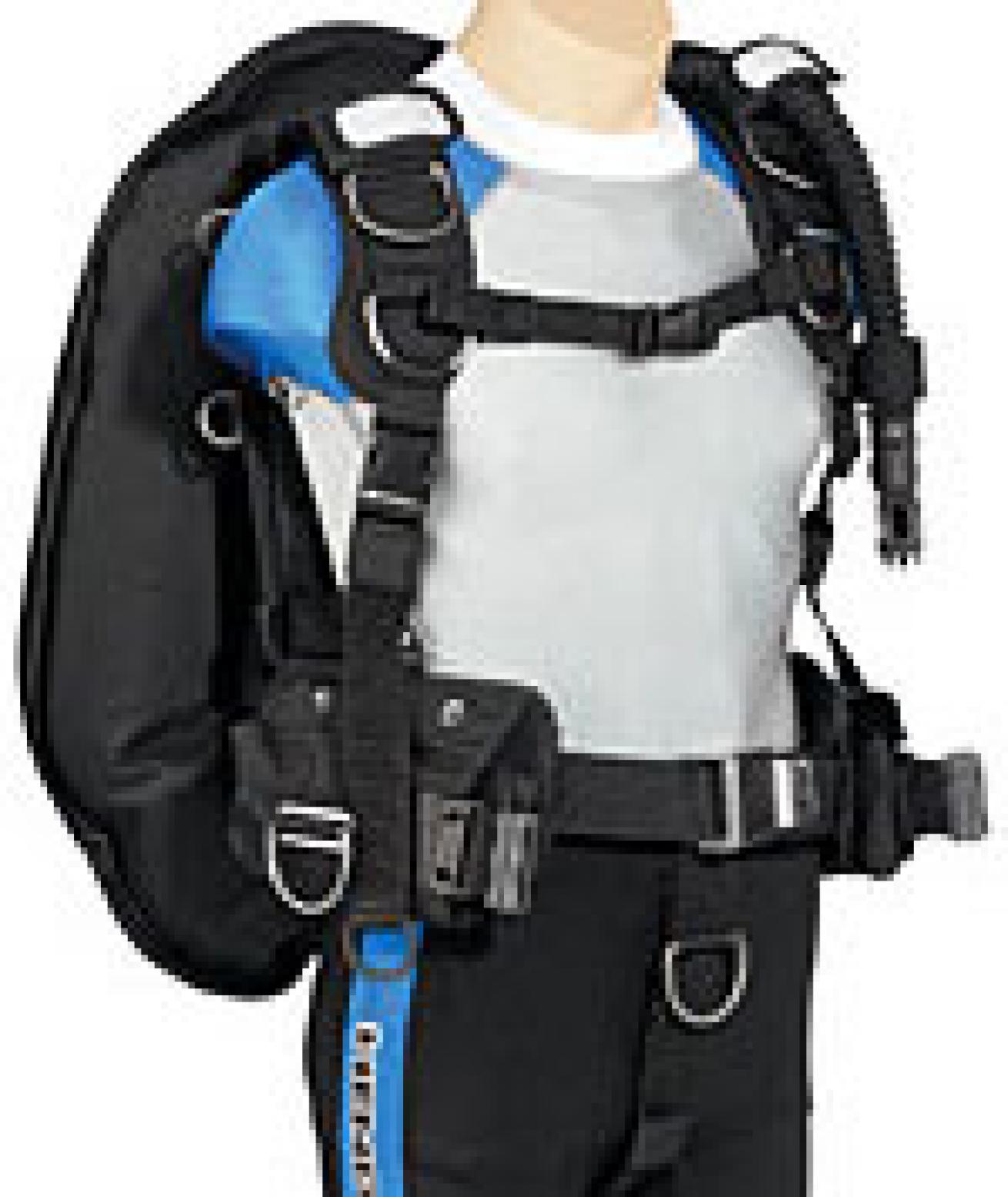
"Rugged," "adjustable," "versatile" and "comfortable" are some of the words test divers used to describe the Apeks WTX series BC. This modular system allows the diver to choose a harness, air cell and accessories to fit his specific needs. The unit we tested included the WTX harness, WTX 3 buoyancy cell, and the SureLock weight system. In this configuration, the BC is a soft pack with two tank bands, but can be used with a metal backplate for double tanks. This impressed the most experienced tech diver on our team, who commented, "I would buy this." Some test divers thought the WTX a bit complex for single-tank diving, but agreed it had "all the right stuff," and the scores clearly put it into the Testers' Choice category. The SureLock weight system was one of the easiest to load and ditch and earned the WTX one of only two Excellent ratings for weight ditching. The two-inch webbing straps, backed by shoulder pads, are very comfortable, as was the thick, removable backpad. A two-inch crotch strap, which prevents tank shifting, also helped the WTX earn an Excellent rating for swimming attitude and stability. The heavy-duty power inflator operated efficiently, but most test divers found it to be bulky. On the plus side: The WTX was one of two BCs in this review to register zero inherent buoyancy.
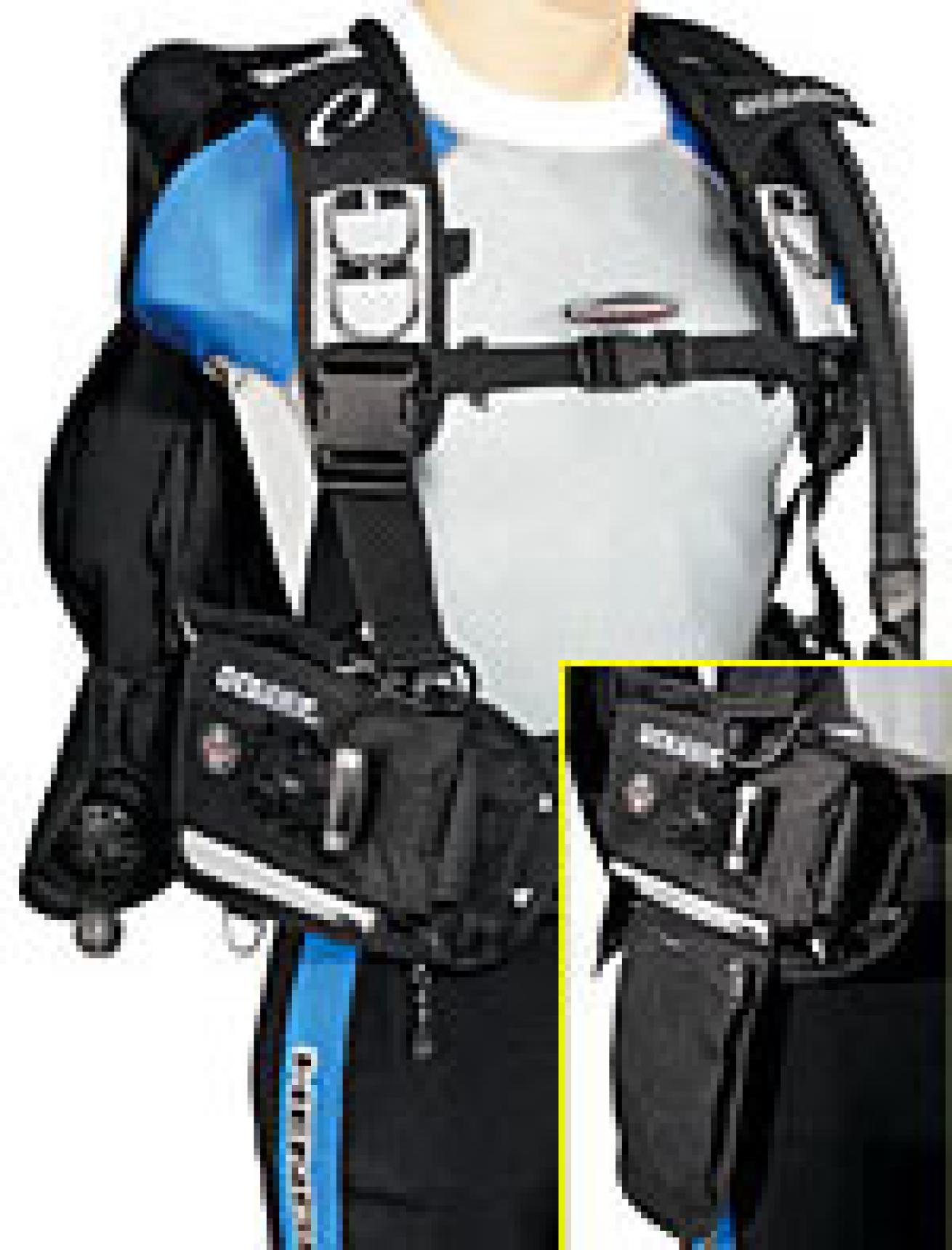
Oceanic Excursion
SCUBA DIVING Testers' Choice
The Excursion BC from Oceanic is rigged and ready for the wreck or reef and offers all the features needed for taking that first tech course. Warm-water divers will like the padded backpack and rolled neoprene collar for comfort when wearing a thin suit. The patented Bioflex back-buoyancy air cell is streamlined and packs flat in your bag. All straps are finished with plastic D-rings for easy fit and the adjustable cummerbund and multi-position sternum strap offer customizing options. Test divers had nothing but praise for the QLR integrated-weight system. The pouches hold 20 pounds and are secured with mechanical buckles backed with Velcro. There are also two rear weight pouches that can hold up to 10 pounds. Pre-bent stainless steel D-rings are located on the shoulders and bottom rear to accommodate deco bottles. A medium size drop-down gear pocket on the right side can hold a light or accessories while grommets are available on the left for retractors and a knife.
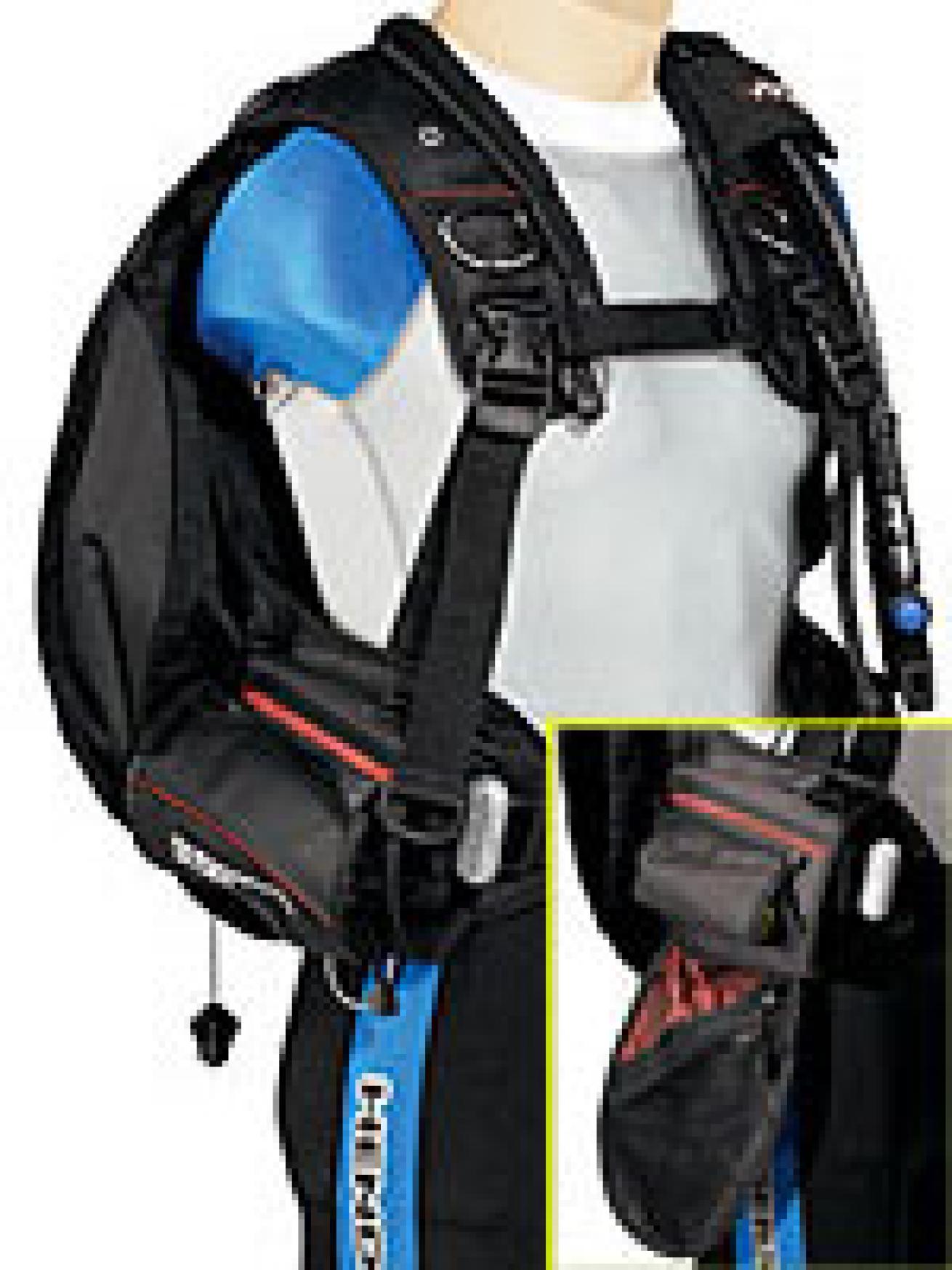
Sherwood Scuba Axis
Very Good Performer
If you want one BC that can pamper you in warm water, yet has the lift and weight capacity for cold water, it's the Axis. The feature-rich BC packs a lot into its streamlined frame. On the left is a small light pocket with an attachment clip, fastex buckle and a stainless D-ring. On the right are a drop-down zippered cargo pocket, fastex buckle, stainless D-ring and a scuba tube pocket. Sherwood's patented CQR weight system holds 20 pounds and two trim pouches hold an additional 10 pounds. Pre-bent stainless D-rings on both shoulders make clipping off gear a snap. The optional BC Pro Kit that is also available includes a large and small retractor, BC knife and halogen pocket light. The CQR weight system loads easily, holds securely and ditches well, and earned a Very Good rating from our test divers. Comfort and Adjustment scores also fell into the Very Good range, due to the plush padded backpack, rolled neoprene collar and long adjustment straps with D-rings. Wide, contoured shoulders provided stable comfort when loaded down, and test divers noted that the Axis was very stable underwater.
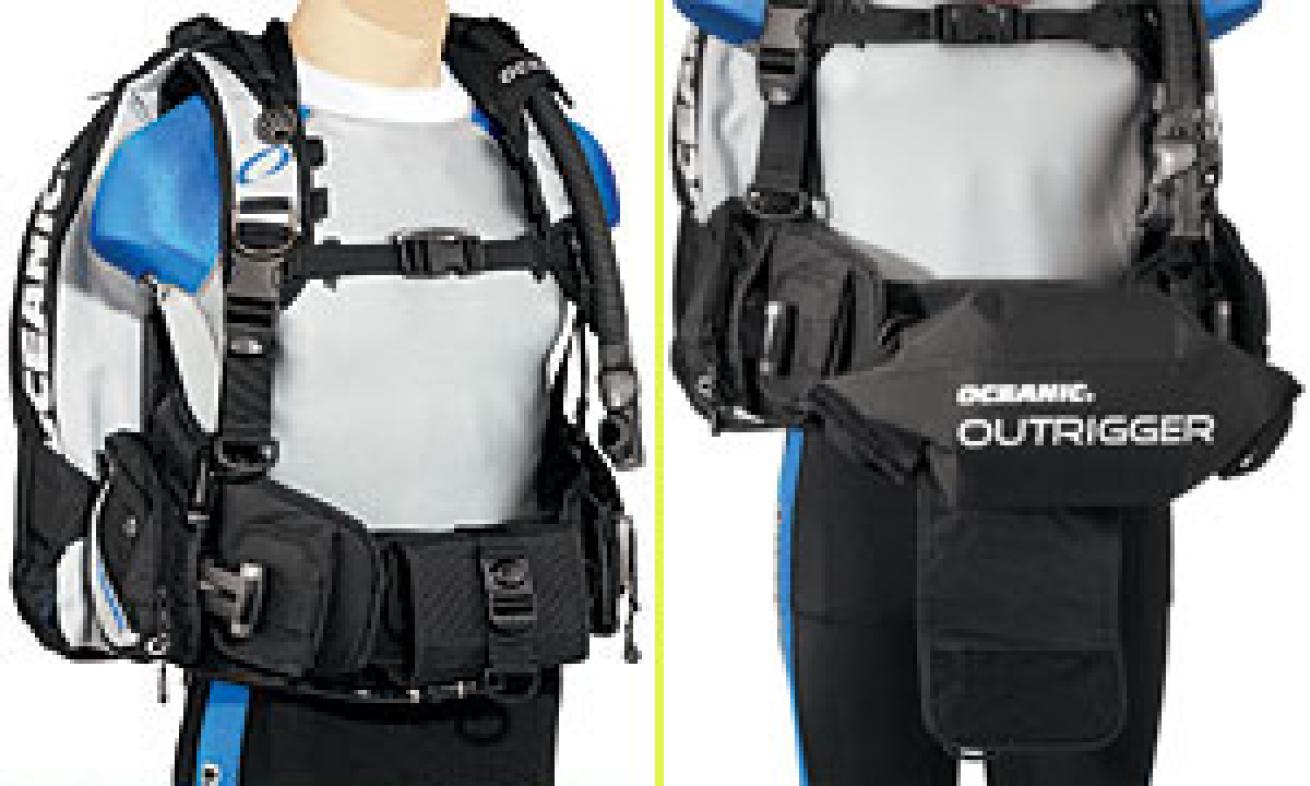
Oceanic Outrigger
Very Good Performer
The Outrigger is a very comfortable and stable back-buoyancy BC with a unique bonus feature. The BC is named for its innovative High Lift Transfer (HLT) system that transfers air from the main air cell to a small pontoon on the cummerbund, which provides an additional 15 pounds of lift at the surface. It's designed to help float the diver face-up and test divers said it works as intended, though most felt the BC was fine without it, too. All adjustment straps are finished with plastic D-rings and shoulder buckles have extended tabs for easy loosening. The elastic cummerbund is adjustable and compensates for depth, while the sternum strap offers three positions. The QLR weight system holds 20 pounds, while rear trim pouches hold an additional 10. Test divers liked the extra security of the QLR weight system, giving it an overall rating of Very Good. The Outrigger also scored high marks for comfort and adjustability, thanks to a padded backpad, velour lining, rolled neoprene collar and elastic cummerbund.
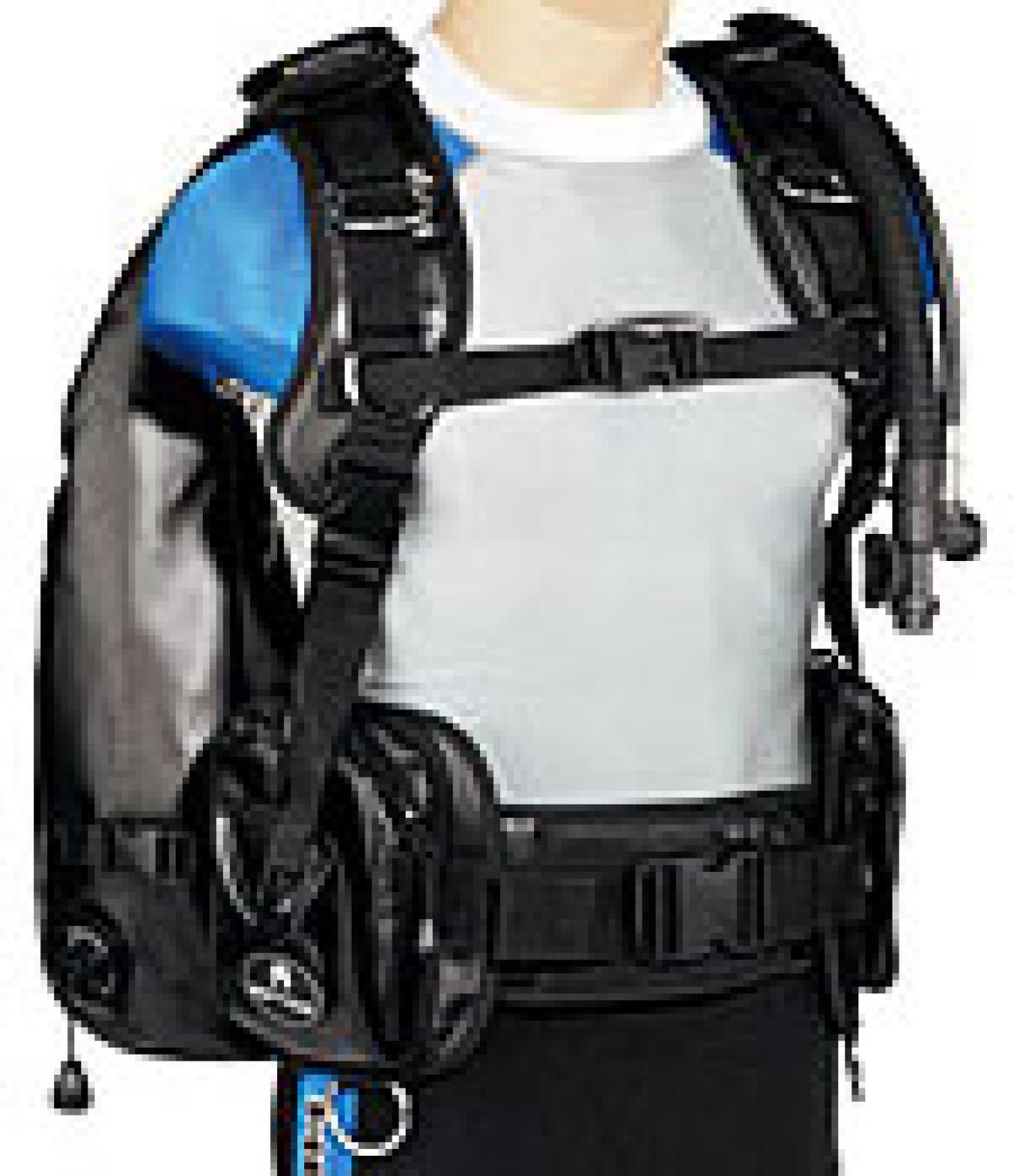
Riptide Rebel
Good Performer
With a shiny black outer shell and biker-inspired logo, the new Rebel from Riptide has a distinctive Easy Rider look. This bad boy BC has a soft side though, incorporating a two-band soft-pack design. The integrated weight pouches hold 24 pounds, and trim pouches can be mounted on either tank band, with each pouch holding up to five pounds. An adjustable depth-compensating cummerbund, webbing waist strap and sternum strap offer a snug fit. A reinforced carry handle and tank-positioning strap make setup and tank changes smooth. The Rebel's integrated-weight system is one of only two in this review that don't use removable pouches. The weight pockets are loaded through a zipper in the top and ditched by pulling on a ripcord-style handle on the outside flap. Loading and Ditching functions both earned a Good rating from test divers. Testers also found the Rebel to be very stable while diving and told us that the old-school inflator was efficient, but slightly bulky. Ergo scores for this BC suffered from the absence of pockets. There's just one small zippered compartment on the front of the cummerbund.
Travel BCs
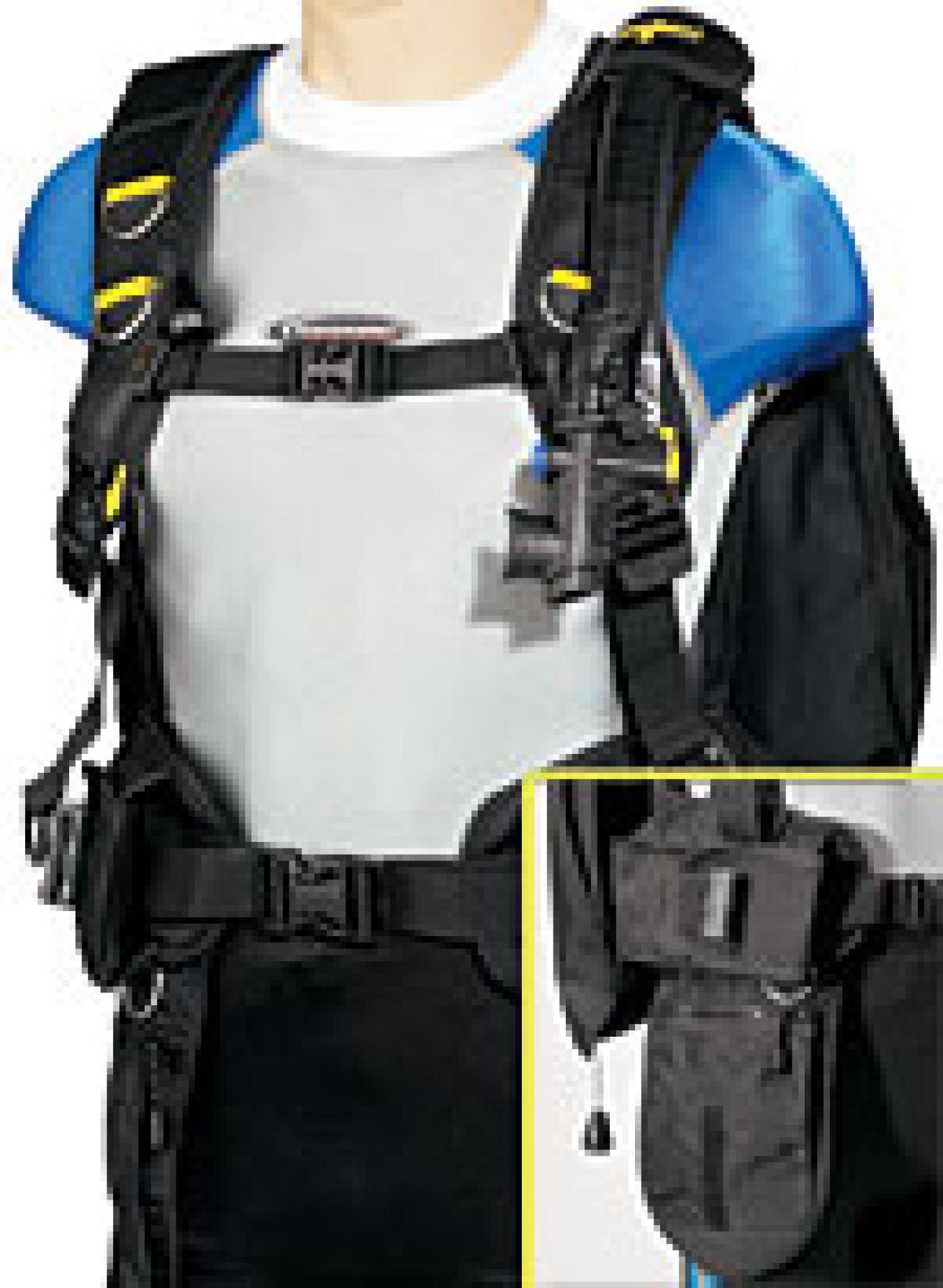
Sea Quest Malibu
SCUBA DIVING Testers' Choice
Simple, quick and portable describes the new Malibu from Sea Quest and explains how it ranked first among these Travel BCs. Slide it on, click two buckles (one for the waist strap, one for the sternum strap), and you're ready to dive. Bonus: The Malibu can be carried, rinsed and stowed in its own built-in mesh bag. Extras are few but useful, including one large drop-down pocket on the right side, five D-rings and grommets for adding a knife or retractor. The Quick Draw weight system scored big with 20 pounds capacity plus an additional 10 pounds in trim pouches. Testers found them to be some of the easiest to load and ditch of those tested. Adjustment scores were Good, thanks to long shoulder straps appointed with D-rings and weaved through buckles with extended tabs for easy loosening. Test divers also found the BC to be comfortable, thanks to velour lining on the shoulders and back.
Cressi-sub Aqualight R
Very Good Performer
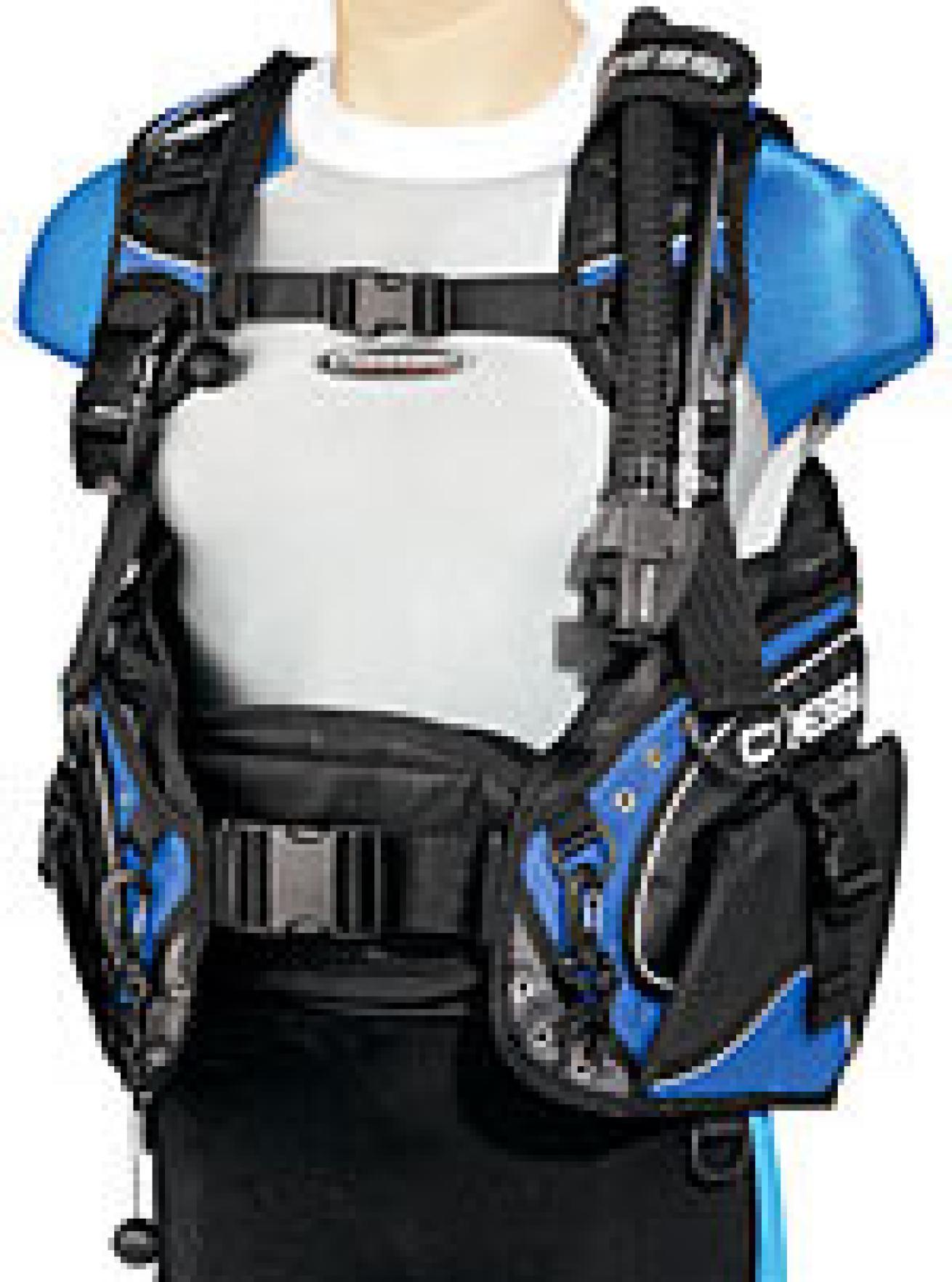
At first glance it's easy to mistake the Aqualight R for just another jacket-style BC, but when you pick up this lightweight model (dry weight: 5.8 pounds) you realize it's been custom-made for tropical travel. Test divers found it to be a very stable BC, thanks to dual tank bands that are webbed together to create a solid connection to the harness. The Aqualight received Good to Very Good ratings in most of the ergonomic tests, but only a Fair rating for weight loading and ditching. The reason? Instead of the detachable weight pouches found on most of the other BCs in this review, the Aqualight uses folding, drop-down weight pouches that open for loading and ditching when you squeeze a quick-release buckle. They work as intended, but compared to detachable systems, test divers said they seemed slightly awkward, especially when it came to loading the pockets while wearing the BC. That said, their comments indicated a fondness for the BC, with praise for precise ascent control, thanks to a slim and responsive inflator that fits well in the hand. They also liked the placement and operation of the pull dump toggles, which are easy to find and use.
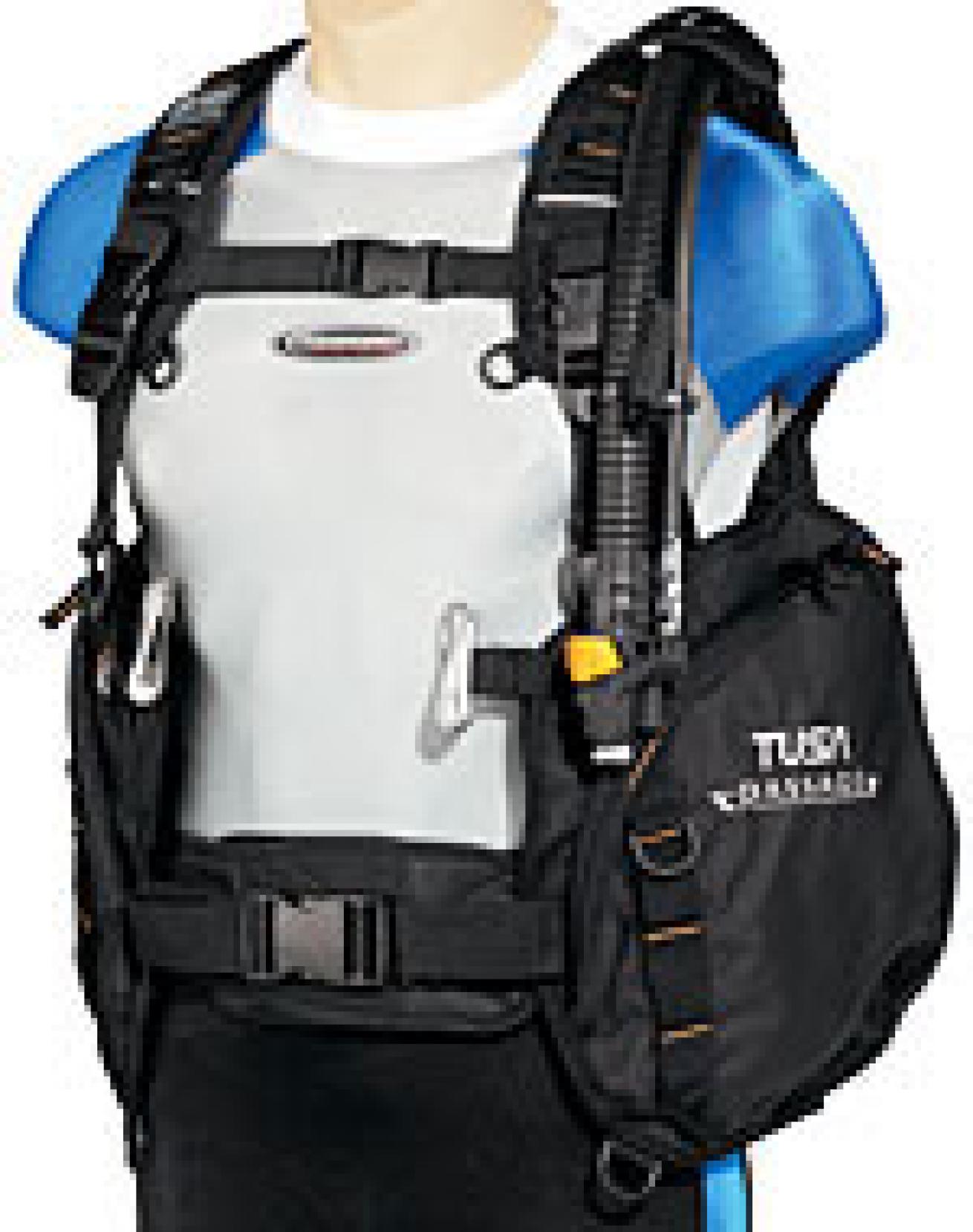
Tusa Passage
Very Good Performer
The Passage is a light (less than 5.5 pounds), durable (made from 420 denier nylon), and comfortable BC that offers excellent stability. The tank is secured between two rails to prevent wobble, and an additional stabilizing strap and tank-positioning strap make the connection rock solid. The Integrated Stabilizing Harness, which incorporates an adjustable cummerbund, shoulder straps and a waist strap, provides a snug, comfortable fit that is unaffected by changes in the air cell. The integrated-weight system holds 16 pounds in detachable pouches, which is sufficient for most warm-water divers. The weight pouches slide into dedicated sleeves at a 45-degree angle, which makes them somewhat awkward to reach when it's time to ditch. But the main issue test divers had with the system was in loading-the pouch handles must be lined up just right with the Velcro tabs to ensure security. All in all, test divers liked the Passage, giving it Very Good scores for Ascent Control and Comfort. There were positive comments on the streamlined inflator, which has a bright orange inflate button that is easy to recognize.
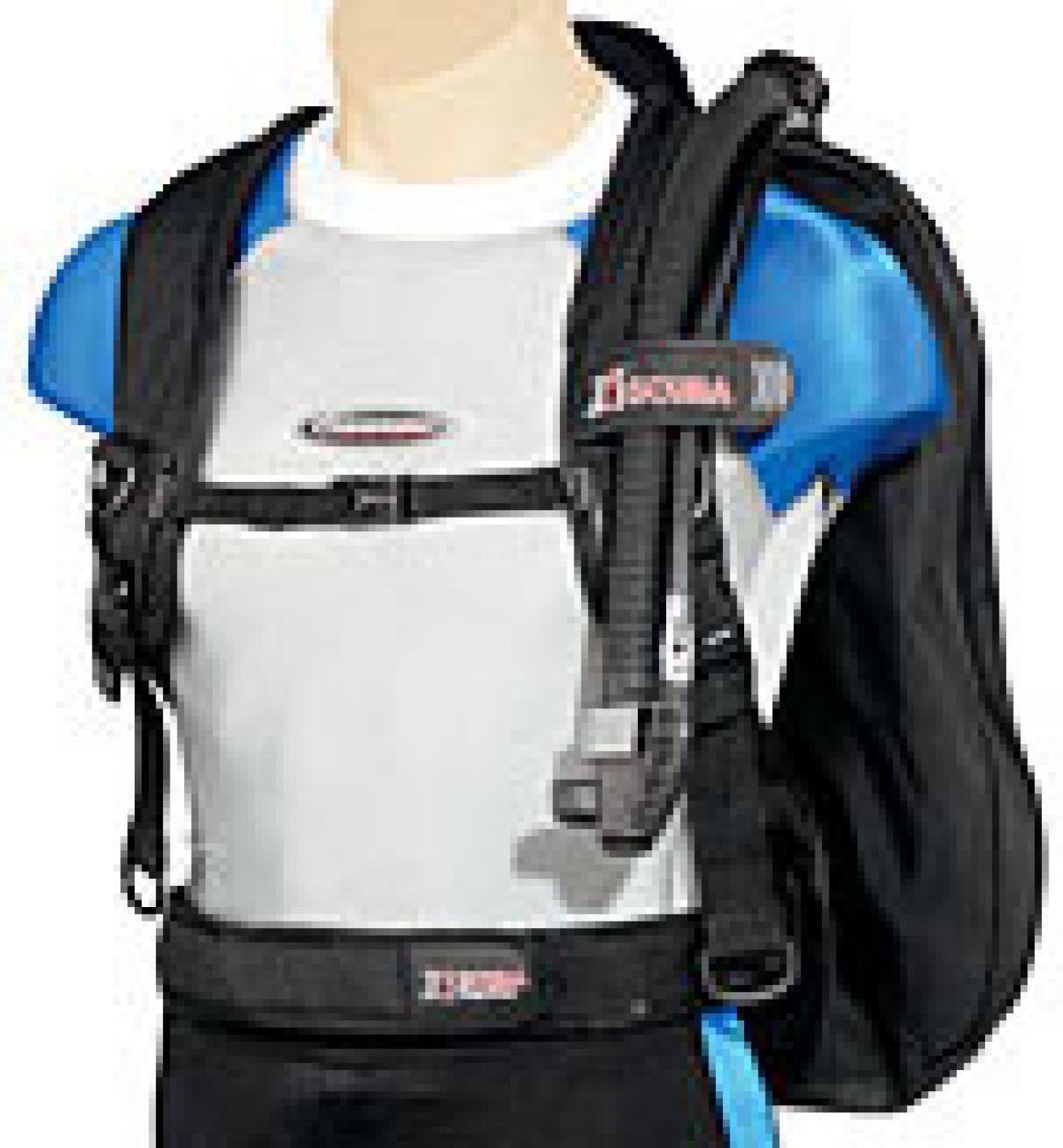
XS Scuba Companion
Fair Performer
The new Companion from XS Scuba is a bare-bones BC designed for those quick getaway trips to the tropics. The Companion is actually the marriage of XS Scuba's Pony Pack harness and its 30-pound air cell. It features a semi-soft MicroPac with two tank bands. The overall rig is light (five pounds) and folds flat in the bottom of your bag. This BC is so stripped down it's easier to point out what it doesn't have: weight pockets, trim pockets or stowage pockets. It does have an adjustable Velcro waist strap, shoulder straps with easy-to-adjust buckles, a rolled neoprene collar, a padded velour backpad and just two D-rings. The Companion earned Good scores across the board, but divers found the adjustability to be lacking compared to others tested. All in all, it's a super simple design that's great for warm water, but lacks the adjustability needed in cold or temperate waters.
Dive In
Ergonomic Testing: The Human Touch
Ergonomics is a fancy word for how gear fits, feels and functions in everyday use. And the only way to evaluate the ergonomics of a product like a BC is to put it into the hands of real people. That's why the feedback we get from our diverse team of volunteer test divers is so important to these reviews.
Representing a cross-section of the sport in terms of age, gender, experience and diving interests, our test divers are your stand-ins, doing what you would do if you could-namely, dive the heck of out of each BC submitted for review. On each dive, test divers used a pre-printed scorecard to evaluate each BC in eight specific areas of performance using a 1 to 5 scale (5=Excellent, 4=Very Good, 3=Good, 2=Fair, 1=Poor). They are also instructed to provide written comments on specific features as well as their overall impressions of the BC. The areas of ergonomic evaluation are grouped into three categories-Most Important, Moderately Important and Convenience Items as follows:
MOST IMPORTANT
Ascent Control: An evaluation of how easily the BC can be used to control a normal ascent.
Attitude and Stability: Evaluated while swimming under water to determine if the BC will keep the diver in the proper swimming position without wobbling.
Weight Ditching: An evaluation of how easy or difficult it is to ditch weights in a simulated emergency situation.
MODERATELY IMPORTANT
Valve Operation: Evaluated by the ease with which a diver can find and use the oral and power inflators, the oral deflate held overhead, the pull dump and the remote exhaust valve(s).
Comfort and Adjustment: Checked both in and out of the water with the BC strapped to a tank.
CONVENIENCE ITEMS
Assembly: Performed on deck without instructions. Although BCs should be supplied with clear and complete instructions, most divers will not take the instructions with them on the boat.
Weight Loading: An evaluation of how easy or difficult it is for a diver to load weights and secure the system while wearing the BC.
Pockets: Tested in and out of the water, this is an evaluation of how easy or difficult it is to access and use pockets.
Still Looking for the Perfect BC?
These Testers' Choice models from the 2005 Scuba Lab review of travel BCs are still on the market and worth a look. For full details, see the Gear section of www.scubadiving.com.
Sea Quest Balance One of 2005's top-scoring BCs, the Balance is as comfy as they come thanks to an expandable waist strap (it replaces the traditional cummerbund), unique shoulder swivel buckles and a triangular load distribution strap system. This back-buoyancy model also uses Sea Quest's efficient Sure-Lock mechanical-release weight system. Weights load easily and ditch like a dream. Price: $535.
Sherwood Scuba Tortuga The travel-friendly Tortuga has a sweet integrated-weight system that puts ballast pouches and locking mechanisms up front where they're easy to reach. It's a comfortable BC, with a thin layer of velour-covered padding that cushions the back and lumbar areas, more substantial padding underneath the shoulders, and a nice neoprene neck roll. It also has a nicely designed power inflator that fits comfortably in the hand. Price: $475.
Sea Quest Passport This jacket-style BC comes with its own integrated mesh carry bag. When not in use, the bag stows behind the backpad, providing additional lumbar support. The design keeps things simple, but the BC has everything you need for stable, comfortable diving. An efficient power inflator simplifies ascent control and the integrated-weight system is easy to load and ditch. Price: $349.
Genesis Scuba Tropic The back-inflation Tropic has an excellent integrated-weight system, efficient adjustments throughout and comfortable shoulder and back padding. Test divers found it to be a very stable BC thanks to dual tank bands and a semi-rigid backpack. They also loved the power inflator, which has a good angle to its mouthpiece and easy-to-operate buttons, enabling you to inflate and deflate without changing hand positions. Price: $350.
Zeagle Stiletto The back-inflation Stiletto is one of Zeagle's most popular BCs, thanks to comfy lumbar padding and Zeagle's PFS (Personal Fit System) sizing, which lets you choose from five vest sizes and five shoulder strap sizes for the best possible fit. The Stiletto is equipped with Zeagle's patented "Ripcord" weight-release system. Weight pockets are tied together with a threaded cord connected to one handle. A single pull drops all weights. In spite of the heavy-duty materials and copious padding, this BC folds up pretty compactly for traveling, and it has virtually no inherent buoyancy. Price: $539.
Oceanic Islander Nice velour-covered padding on the back and lumbar region, a rolled neoprene neck and cushy shoulders soften the load when diving the Islander in tropical locales. And rather than offering D-rings for attaching gear, the Islander comes with 16 looped attachment points to which you can clip carabineers (two are included) right where you need them. Offering a stable ride at depth (the BC has no inherent buoyancy), the Islander's shoulder straps snake underneath the arms, allowing you to achieve a snug fit while clearing the chest area of clutter. Price: $439.
BC Buying Advice
The single most important thing to look for in a BC is a snug, comfortable fit. Your BC and tank should move with you like an extension of your body, and when you add air to your BC on the surface, it should lift your body, not float off you. When you're trying a BC on for size, here's how to find one that is a perfect fit for your body:
Suit up. Wear the exposure suit you're most likely to use with the BC. Then mount the BC to a tank before trying it on.
Start with the cummerbund. Leave all other straps loose, and tighten the cummerbund (or waist strap if there is no cummerbund) until the weight of the tank rests comfortably snug on your hips. If it's a Velcro closure, there should be about four inches of overlap, so you can adjust for either a thinner suit or a thicker one. If the cummerbund is obviously too short or too long, ask the store personnel to show you how to adjust the length.
Buckle up. Start with the chest strap. Cinch it to a comfortable position. Next, take the slack out of the shoulder straps, but don't overtighten them. Now look in a mirror. Buckles should be in the middle of their adjustment ranges.
Inflate the BC all the way. If there is body squeeze, make sure it doesn't restrict your breathing or mobility.
Deflate the BC. Twist left and right. Walk around the store a little. Your BC and tank should move with you like an extension of your body.
Load it and ditch it. With weight-integrated BCs, load the pouches with the normal amount of weight you wear on a dive. Now, without looking, see how easy and intuitive it is to quick-ditch the weight pockets.
Flow Rates
We test flow rates to determine whether or not a BC's deflation valves will stay ahead of the inflation valve to avoid an out-of-control ascent in the event the inflation valve sticks open. In a heads-up ascent position, starting out with the BC totally empty, the inflation valve was simultaneously activated for 20 seconds with each of the deflation valves to answer the question, "Can the deflate valve in question stay ahead of inflation?" BCs earn a point for each "Yes" listed on the chart below.
||||| |---|---|---|---|
| Name| Inflator/Deflator Held Overhead| Exhaust Hose Pull Dump| Alternate Shoulder Pull Dump| | Aeris Coral| No| Yes| Yes| | Aeris Sporta| No| Yes| N/A| | Cressi-sub Aqualight R| Yes| Yes| Yes| | Mares Dragon| Yes| Yes| Yes| | Oceanic Probe LX| Yes| Yes| Yes| | Tusa Passage| Yes| Yes| N/A| | XS Scuba Nekton| Yes| Yes| Yes| | Apeks WTX| Yes| N/A| N/A| | Oceanic Excursion| No| Yes| N/A| | Oceanic Outrigger| No| Yes| Yes| | Sea Quest Malibu| Yes| Yes| Yes| | Riptide Rebel| Yes| Yes| N/A| | Sherwood Scuba Axis| Yes| Yes| Yes| | XS Scuba Companion| No| Yes| N/A|Late Arrivals
While these BCs were not available at the time of testing, they are in stores now.
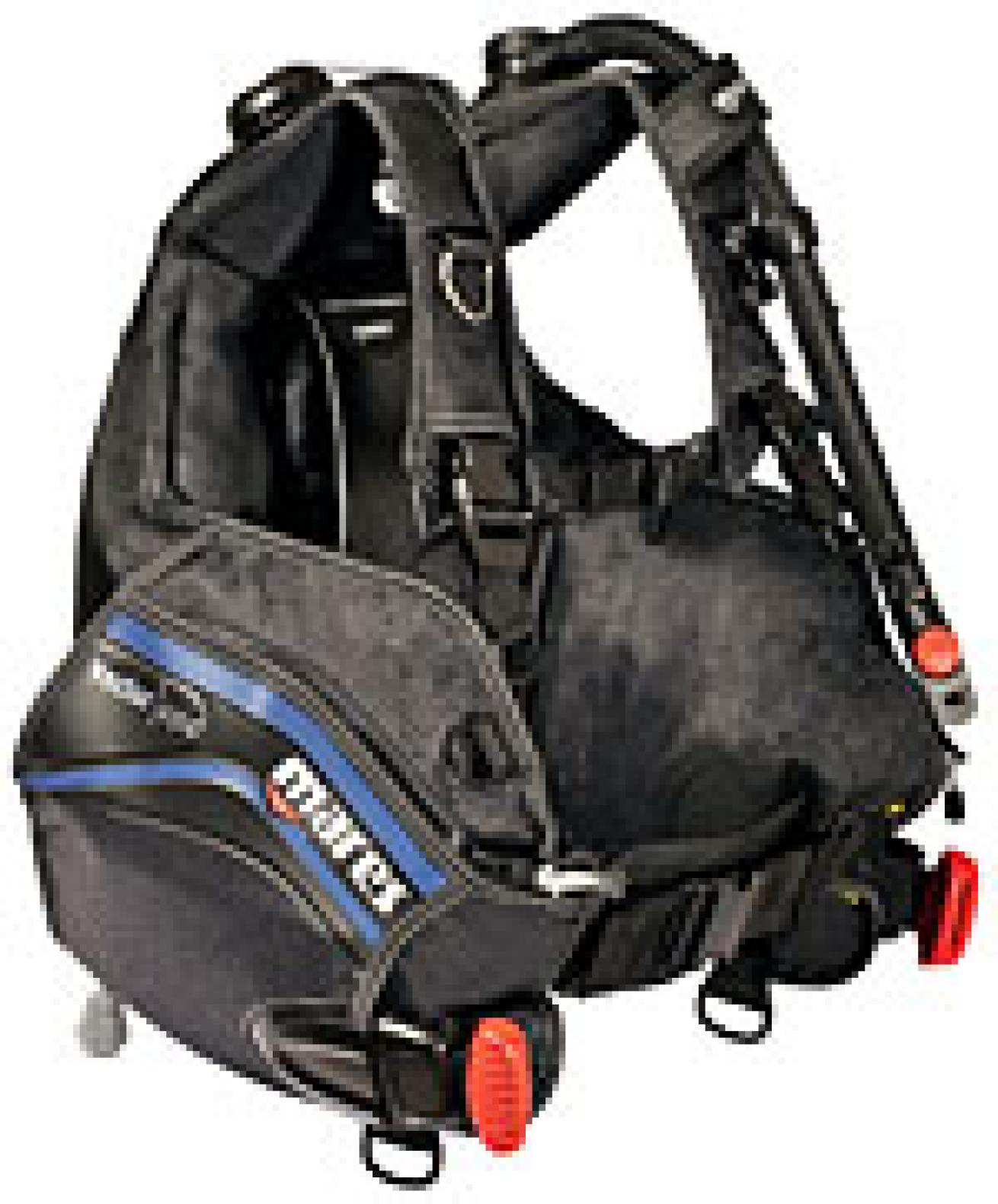
Mares Vector Epic
The Mares Vector Epic is an entry-level, weight-integrated jacket-style BC, whose rugged look is backed up with 420 denier nylon. For comfort it offers the BPS (Back Protection System), an adjustable, depth-compensating cummerbund, and EZ adjust shoulder buckles. It also features the new MRS Plus weight-release system that can hold 26 pounds of ballast. Lift capacity is good at 41 pounds (size large). Two remote dump valves (shoulder, rear) are standard for better control. Two large zippered cargo pockets have extended pull-tabs for easy access. Extras include: a signal whistle, three D-rings, one fastex QR buckle and a double-hose clip. Price: $375.
The DeepOutdoors D2
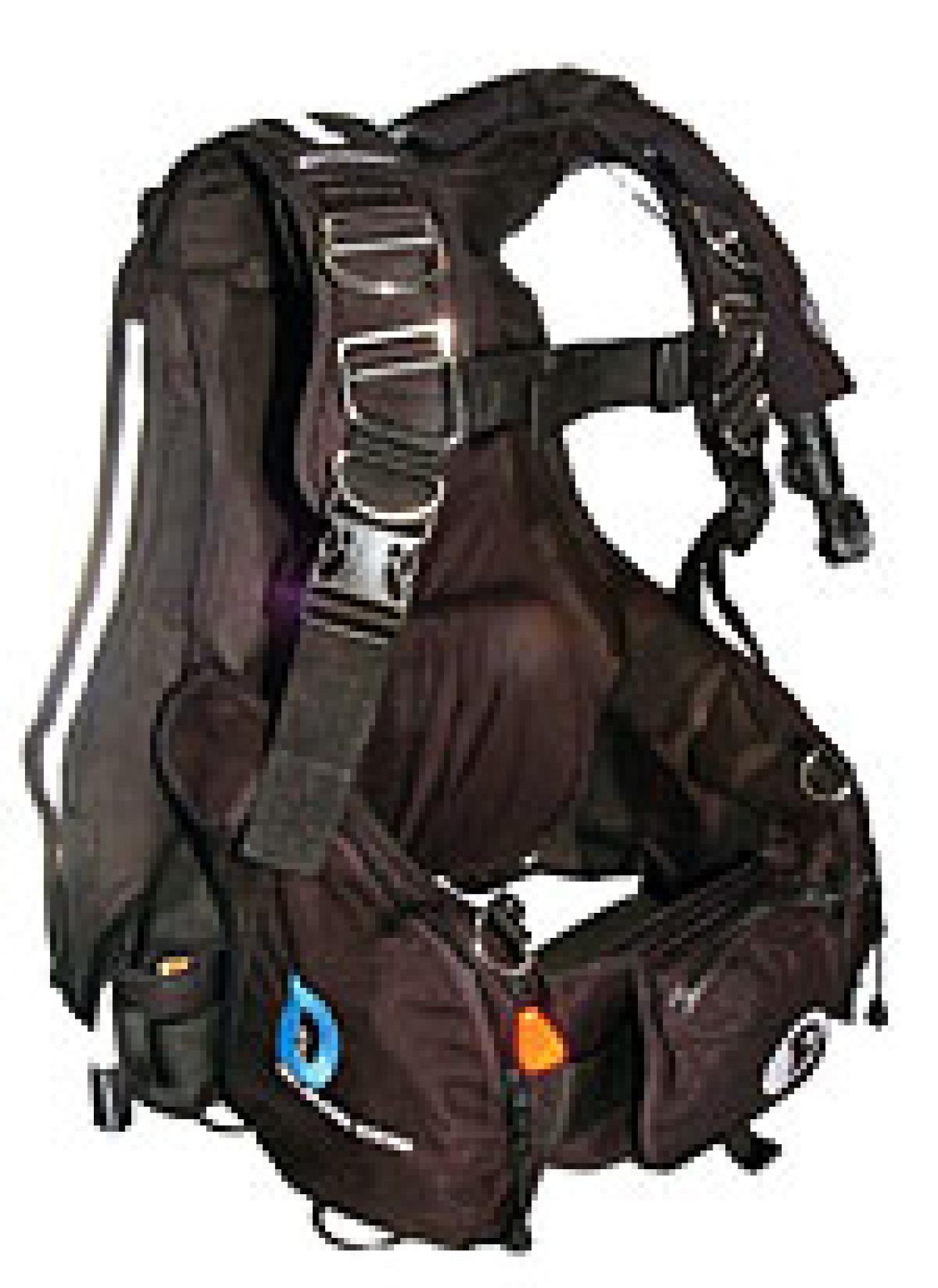
DeepOutdoors combines both back and front inflation with the new D2 BC. The D2 dual inflation system transfers air from the back bladder to the front bladder when a diver surfaces, providing a more upright, natural position, according to DeepOutdoors. Features include the patented G5 Webloc weight system, two external pockets, one belly pouch, and a Velcro cummerbund. The DeepOutdoors D2 is available in XS/SM and M/L. Price: $875.


